St. Peter's Basilica is the greatest Christian church in Rome.
Main Cathedral catholic church located next to the site where Nero's circus once stood, which became famous for the mass executions of early Christians carried out here. There used to be a cemetery on the site of the cathedral. Here, according to legend, Saint Peter was crucified. The first basilica was built over his grave in the 3rd century AD by Emperor Constantine. ">
According to providence, the Apostle Peter came to The eternal City in 43 to become the head of the Christian community. He was in Rome for 25 years. During the persecution of Christians, between the years 64 and 67, he suffered martyrdom in the Circus of Nero on the slope of the Vatican Hill and was buried in the ground, in a cemetery, not far from the road adjacent to the circus. The tomb of St. Peter is the fulcrum of the Vatican, the only reason and essence of all its buildings. If there had not been the grave of the former Galilean fisherman, a witness of the resurrection of Christ, who was sure that he would also be crucified, then a magnificent temple would not have arisen on this site and the beautiful city-state of the Vatican would not exist today.
St. Peter's Tomb became a cult site: around 160, the first enclosure walls and a small marble monument were built here. In 322, ten years after the recognition of Christian religious freedom, Emperor Constantine ordered the construction of the first basilica. It was essentially a temple-mausoleum of the Apostle. In the 6th century, Saint Gregory the Great built a throne for celebrating the Mass. In 1120, Pope Callistus II built an altar over this throne, called the Confession.

In 1452, they decided to rebuild the original cathedral, but only in 1506 did serious work begin. Construction of the temple lasted almost a hundred years, from 1506 to 1616, under 18 popes, from Julius II to Paul V, who inscribed his name on the facade. Many important works were encouraged by Popes Urban VIII and Alexander VII. The fate of the project, implemented and changed, is also difficult 12 great architects. The most famous of them: Bramante, Raphael, Michelangelo, Giacomo della Porta, Domenico Fontana and Carlo Moderno. New St. Peter's Basilica was consecrated by Pope Urban VIII November 18, 1626.
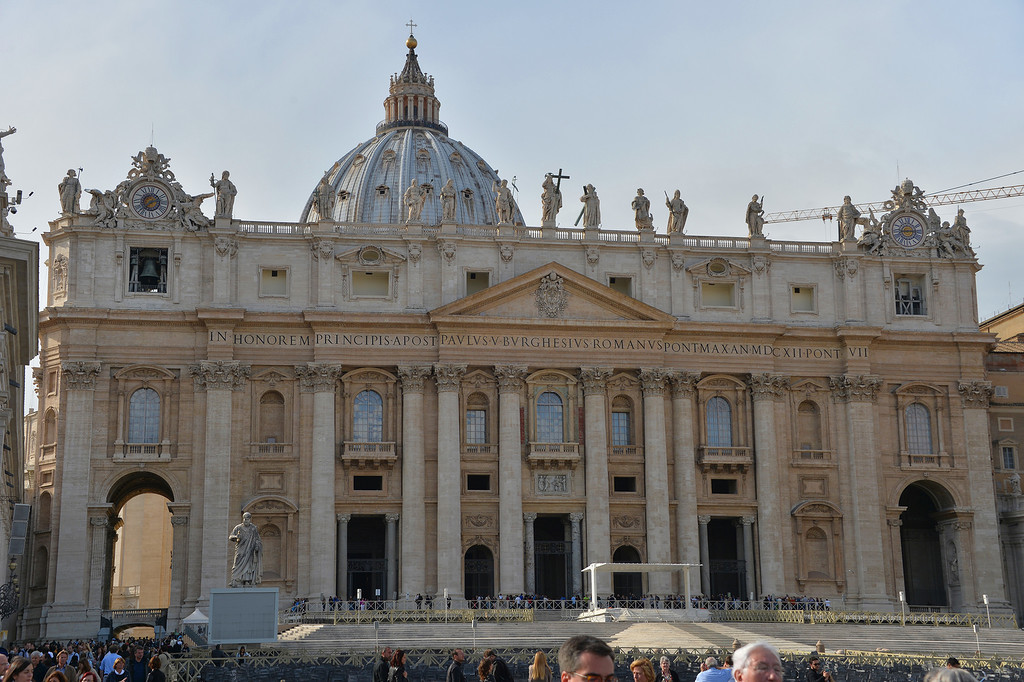
The cathedral occupies more than 44,000 square meters, its length is about 187 meters, its width is 114.5 meters, almost like a football field, and its height is 46 meters. The immensity of the temple is eloquently indicated by the marks on the marble floor in the central nave. Here are the sizes of other large Christian cathedrals, which are inferior to it in size. The decoration of the Cathedral is stunning with an abundance of gold, mosaics, majestic statues of saints, tombstones of popes, and most importantly, amazing creations by Bernini and the young Michelangelo.
In the center, under the pediment, is the famous balcony from which the Pope addresses the faithful.

The basilica is built in the shape of a Latin cross. Until 1989, the cathedral was the largest temple in the world, until it was overtaken by the Basilica of Notre-Dame de la Paix, built in Yamoussoukro, the capital of Cote d'Ivoire, by the way, in the image and likeness of the main character of my story.
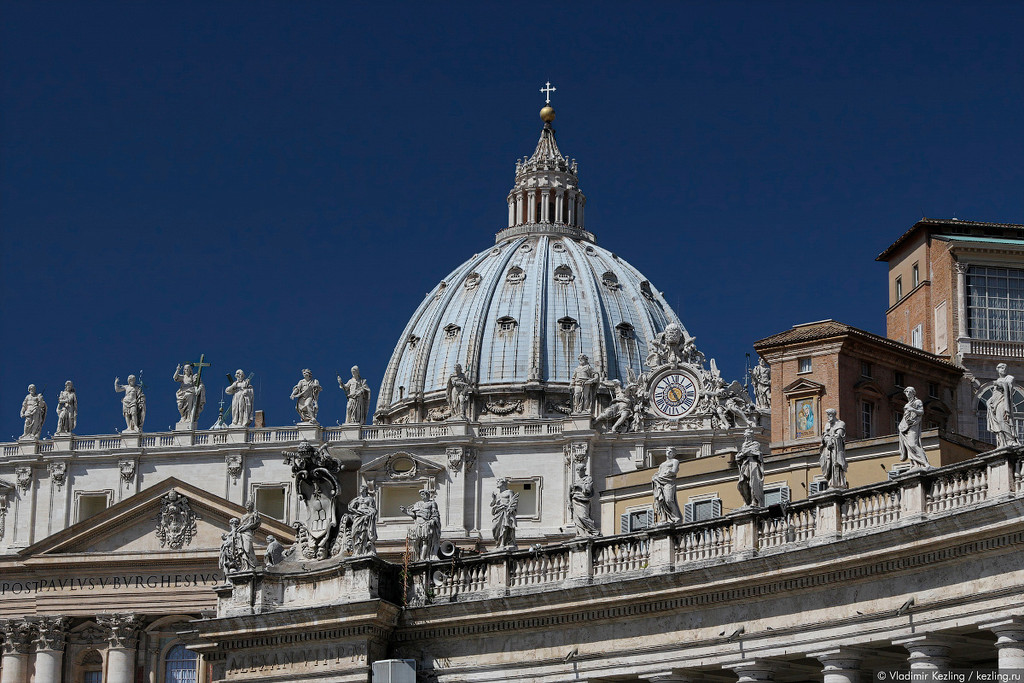
Clock on the facade, with one hand. On the other side there is the same clock, but with two hands.
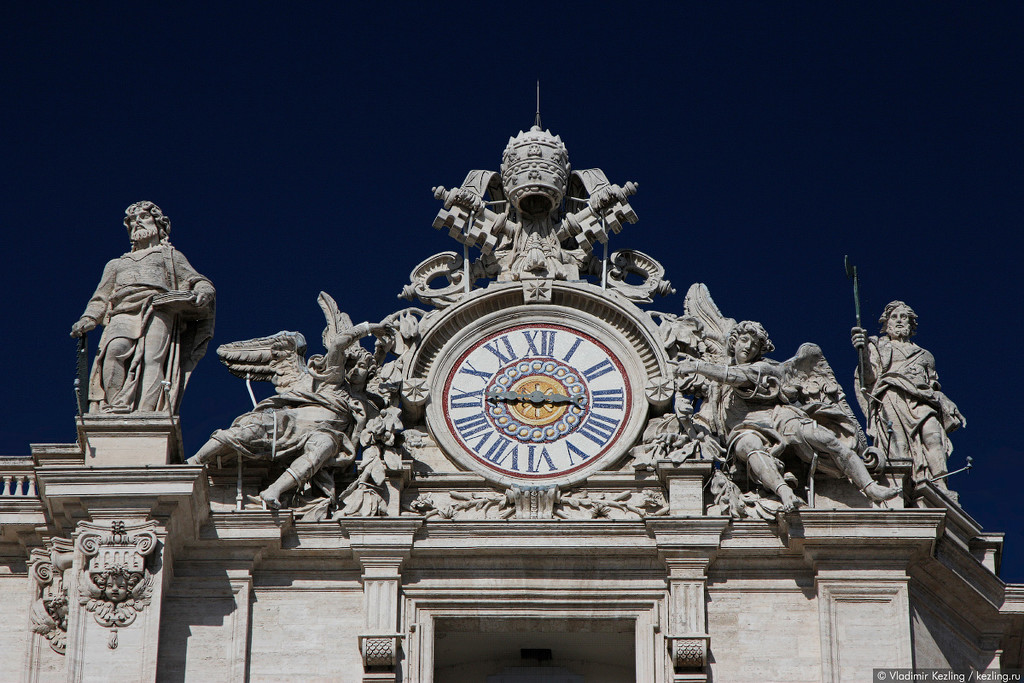
On the roof of the cathedral there are 13 statues - Jesus Christ, John the Baptist and 11 apostles, except the Apostle Peter.
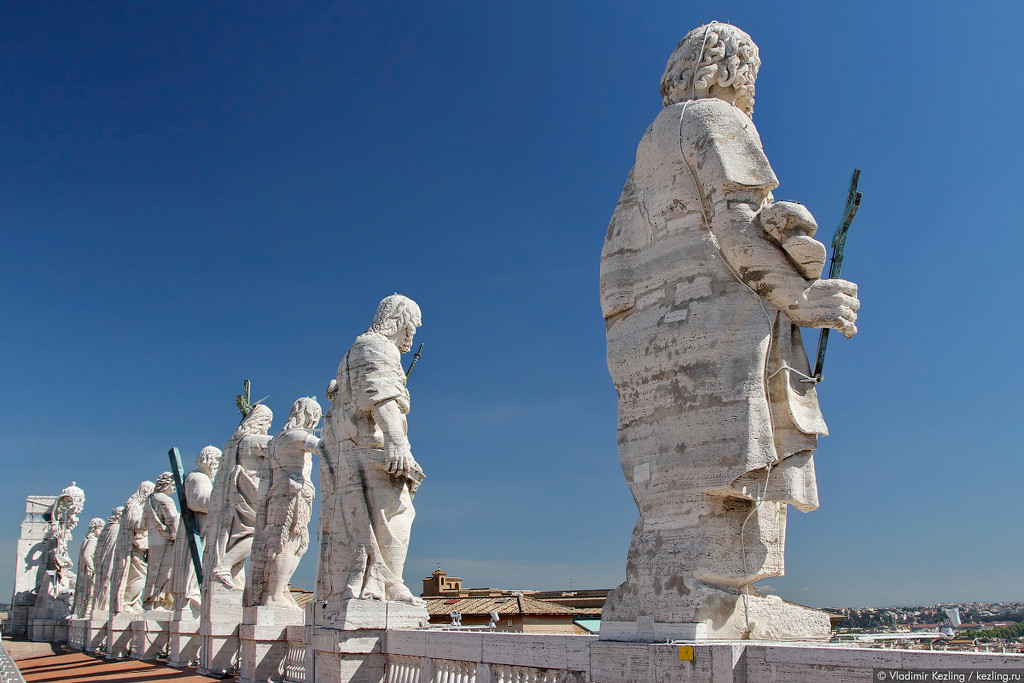
The height of each statue is almost 6 meters.
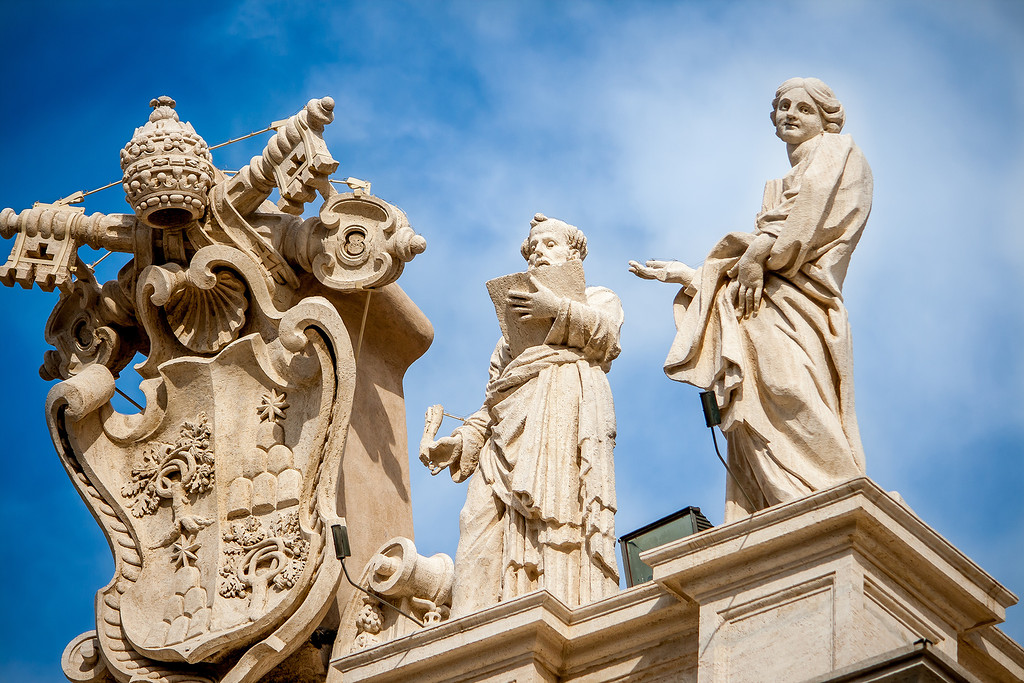
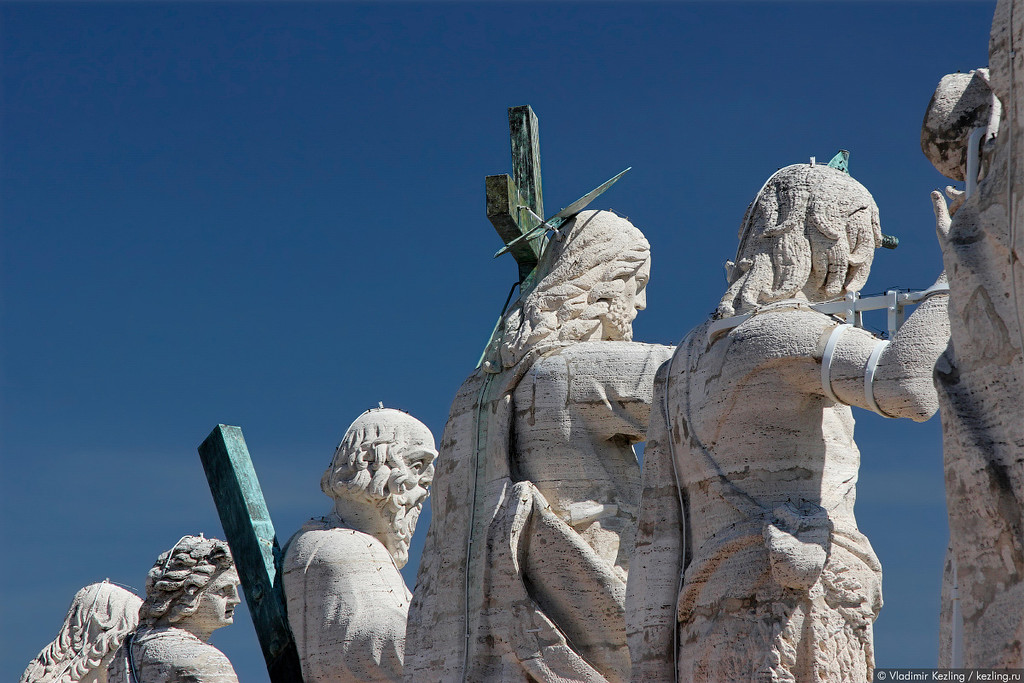
The Vatican Army is the Swiss Guards. Nowadays there are only 110 of them, as you can guess from the name - they are all citizens of Switzerland. It is believed that their shape is sewn according to the sketches of Michelangelo. By the way, this is one of the oldest armies in the world that has survived to this day. True, it took part in hostilities only once - in 1527, when Rome was sacked by the troops of the Holy Roman Emperor.
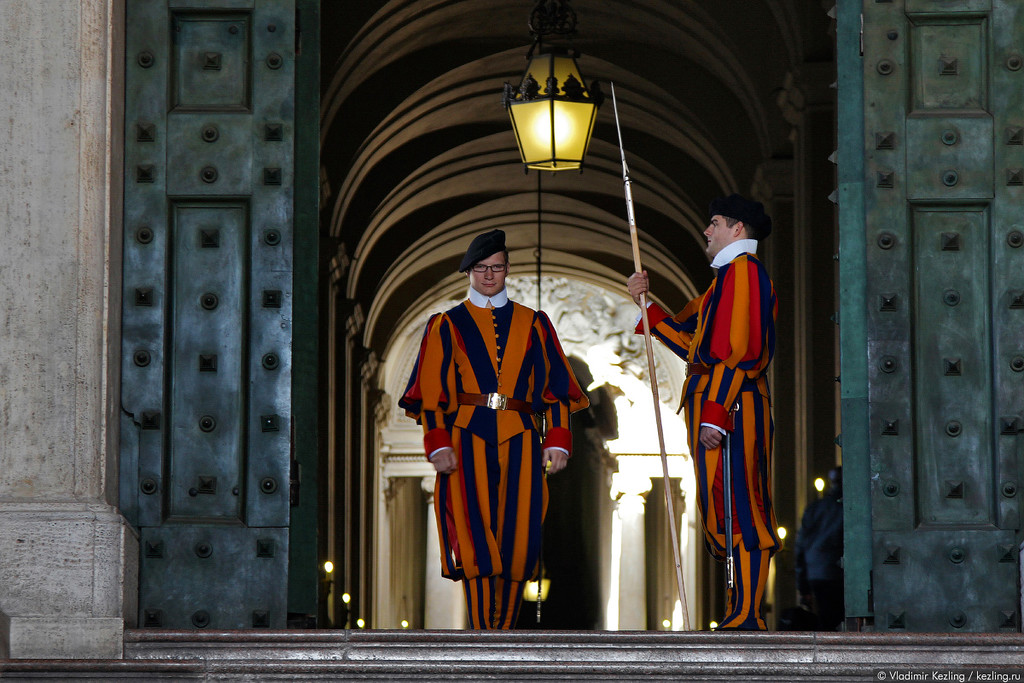
Swiss Guard

Holy Gate
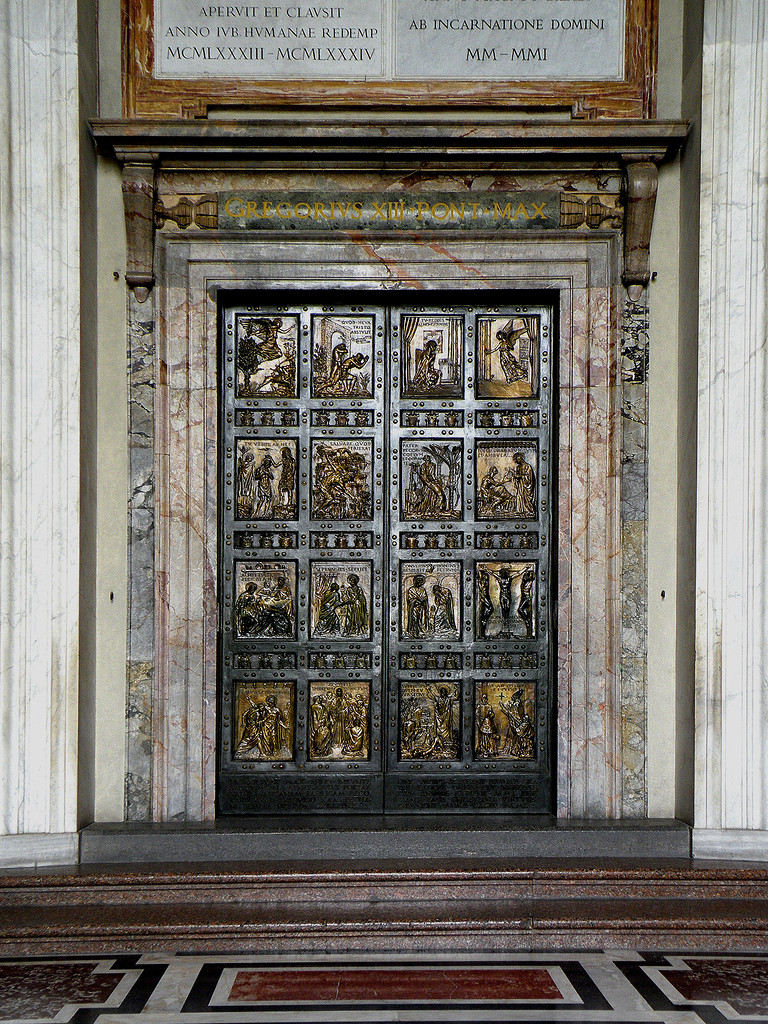
The cathedral is huge. It seems like you are entering along with a huge crowd, but inside this crowd suddenly disperses throughout the dimensionless hall and becomes completely invisible. During festivities, the cathedral can accommodate up to 60 thousand people.
The length of the central nave is 211 meters.

All this is no less impressive than the Hagia Sophia in Istanbul, which until the construction of St. Peter's Basilica remained the largest Christian church in the world.
general view of the hall.

Ceiling
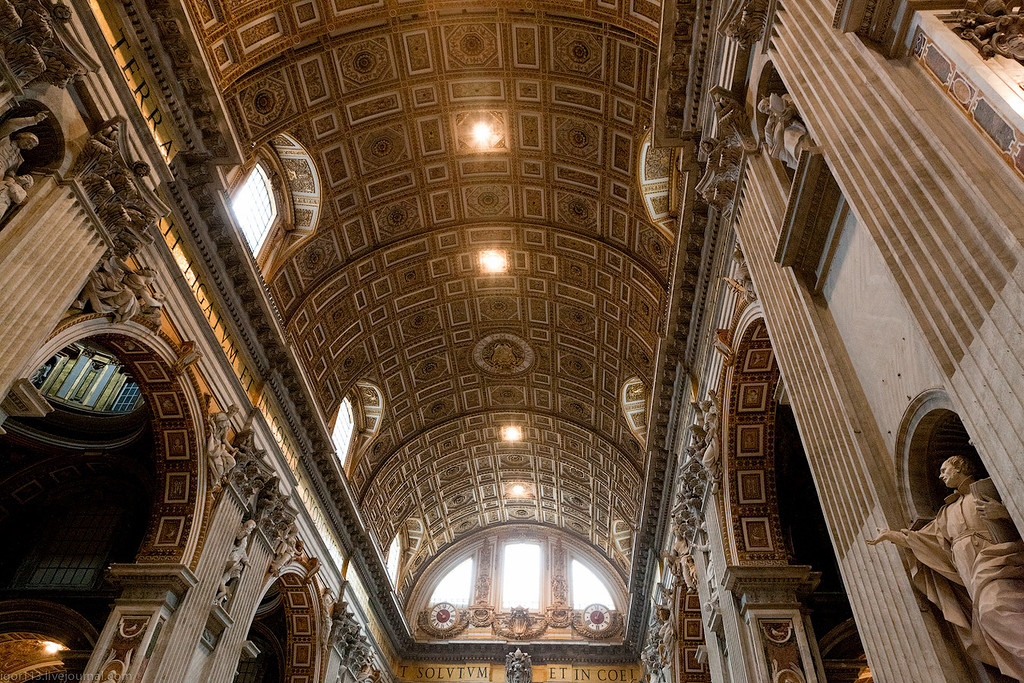
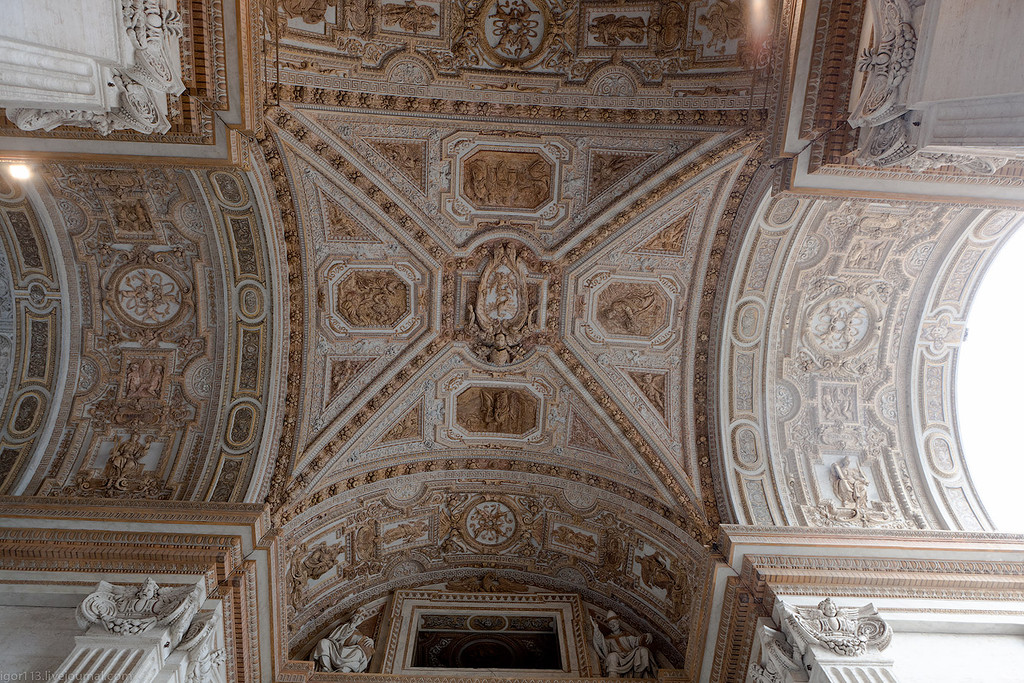

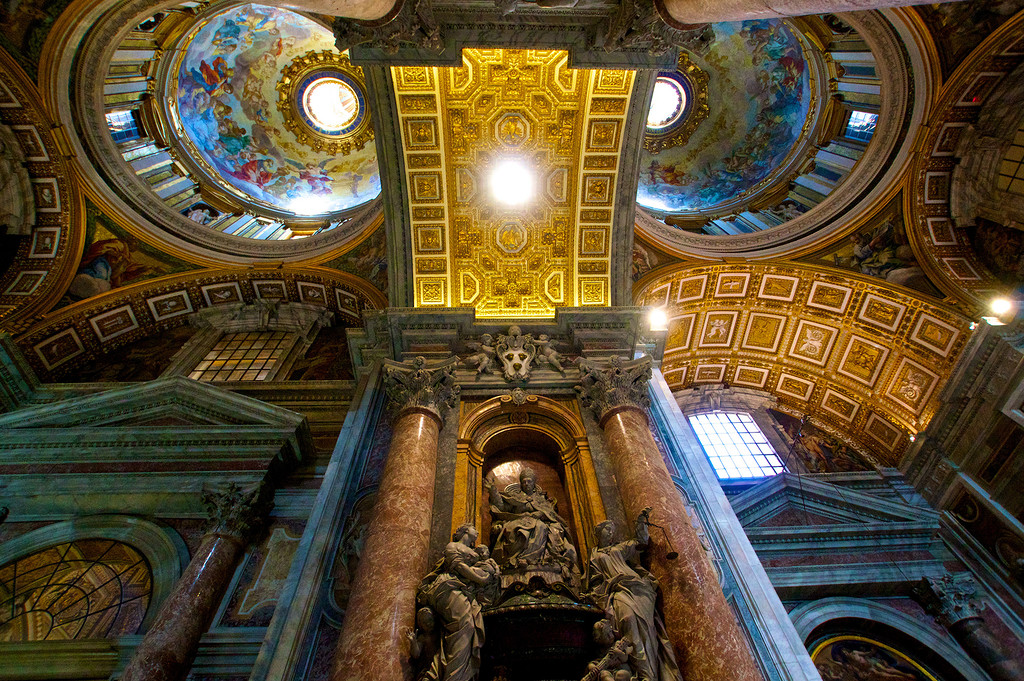
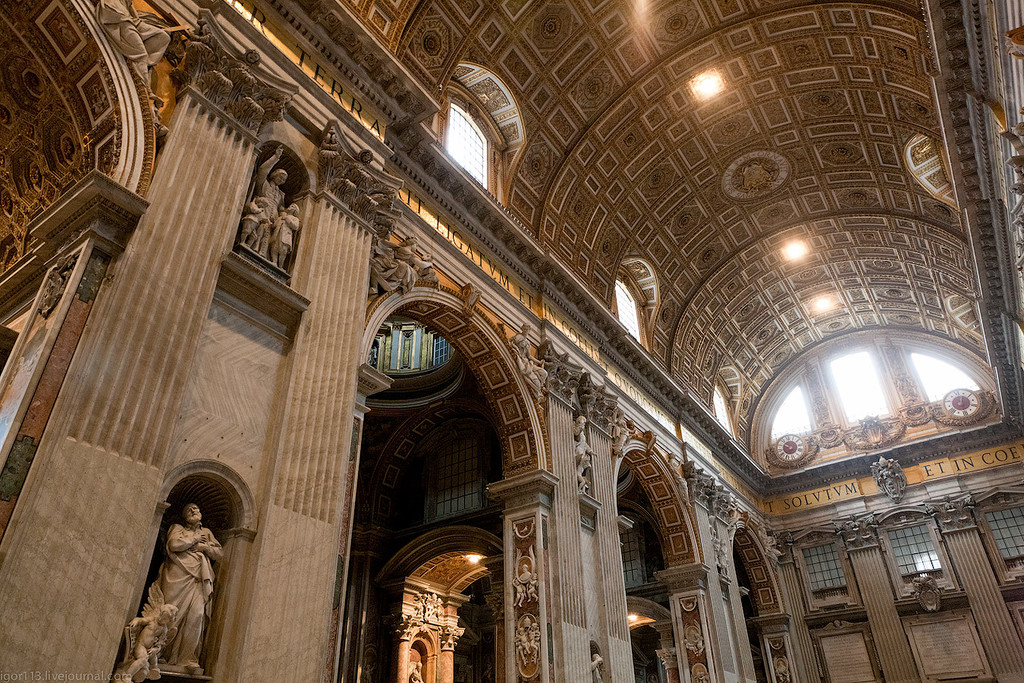


The interior of the cathedral is beautiful and solemn to the point of ripples in the eyes. Moreover, unlike Orthodox churches, this splendor and luxury are not at all flashy. You can admire the exquisite details for an endlessly long time - there really is something to look at.

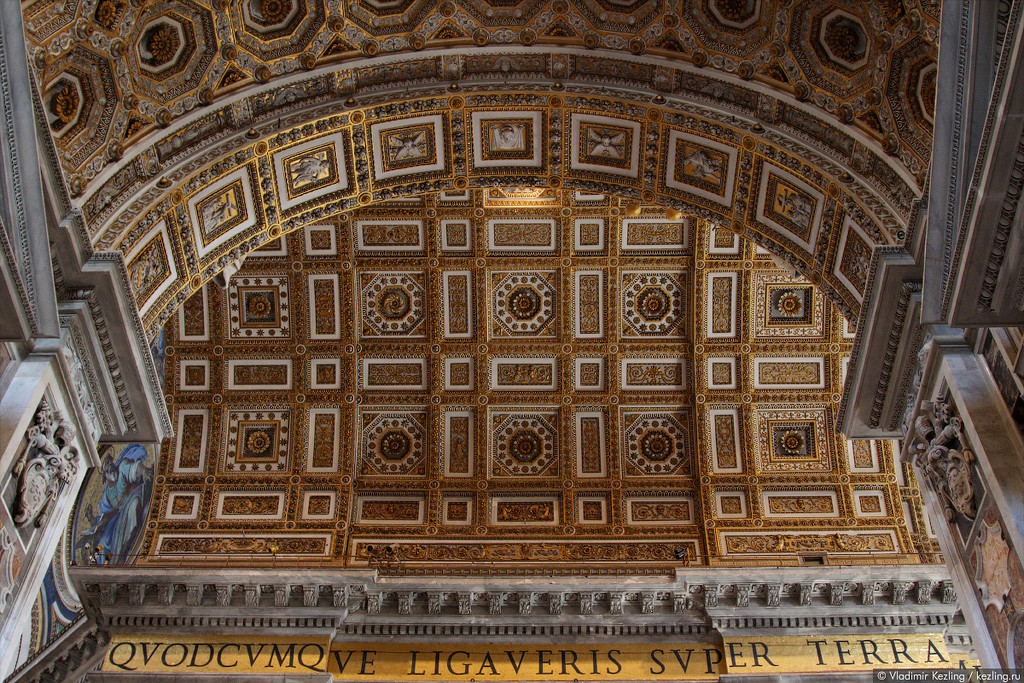


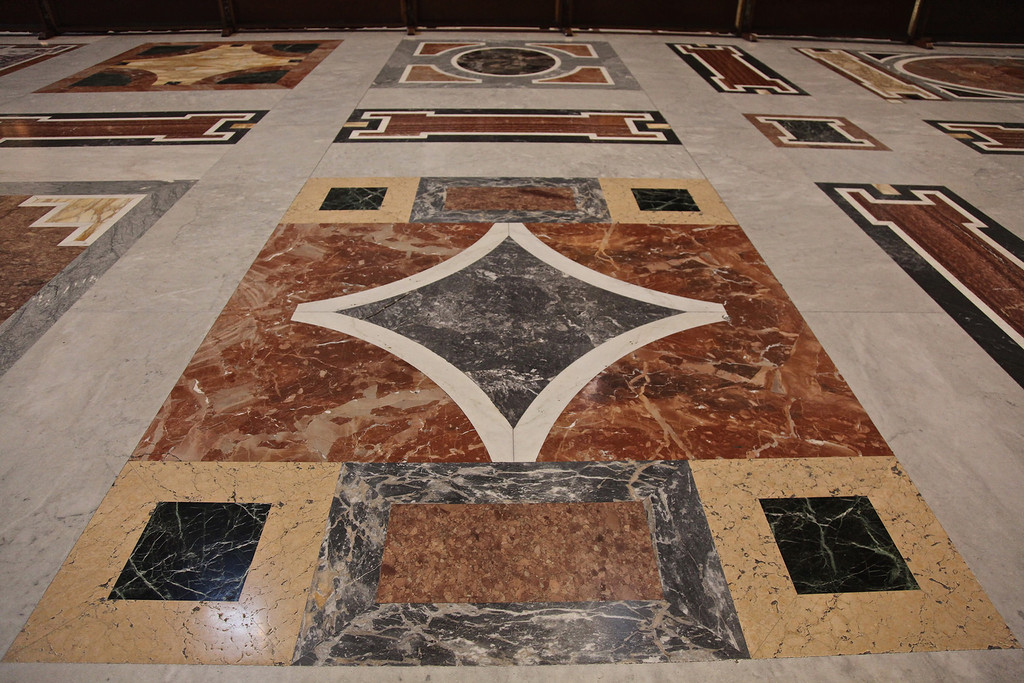
Central nave
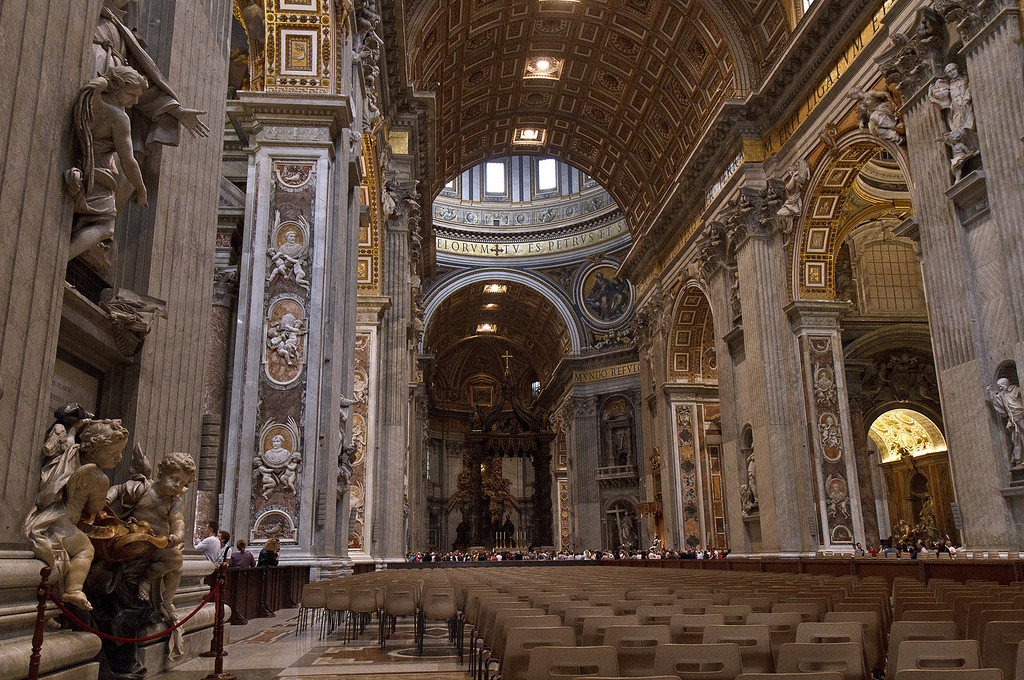
The total length of the basilica is 211.6 m. On the floor of the central nave there are marks showing the dimensions of other largest cathedrals in the world, which allows them to be compared with the largest Cathedral of St. Petra.
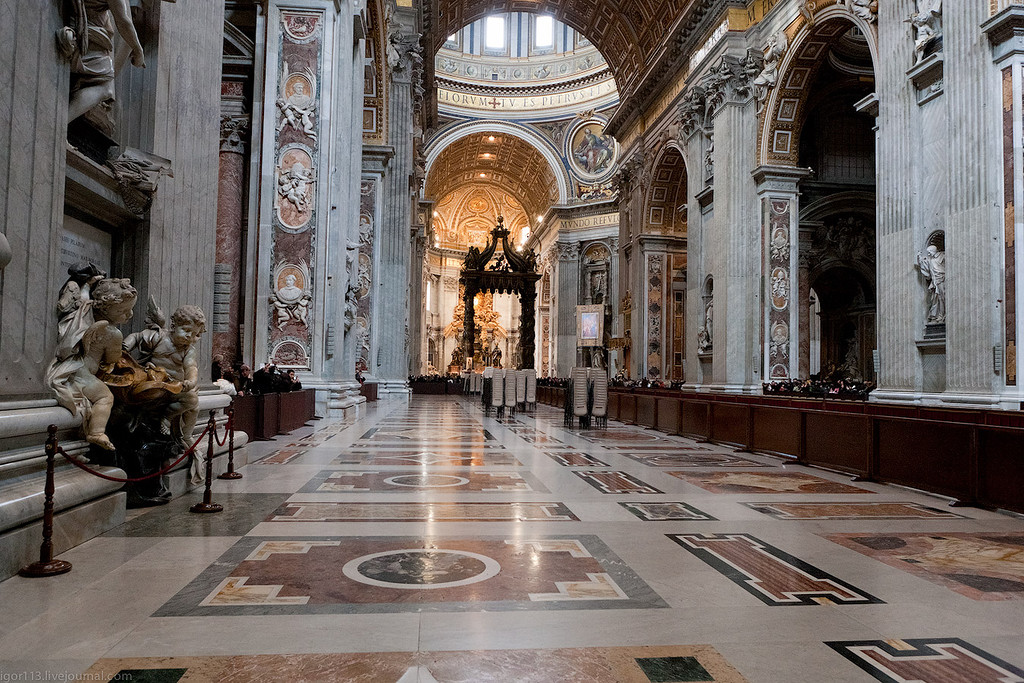
At the end of the central nave, at the last pillar on the right, there is statue of st. Peter XIII c., attributed to Arnolfo di Cambio. The statue of St. Peter, made of bronze in the 4th century by an unknown Syrian sculptor, enjoys extraordinary fame. It is believed that if you touch it and pray, your prayers will be heard. This custom is very ancient, so one foot of the statue is erased from the touches of worshipers.
Statue of St. Peter
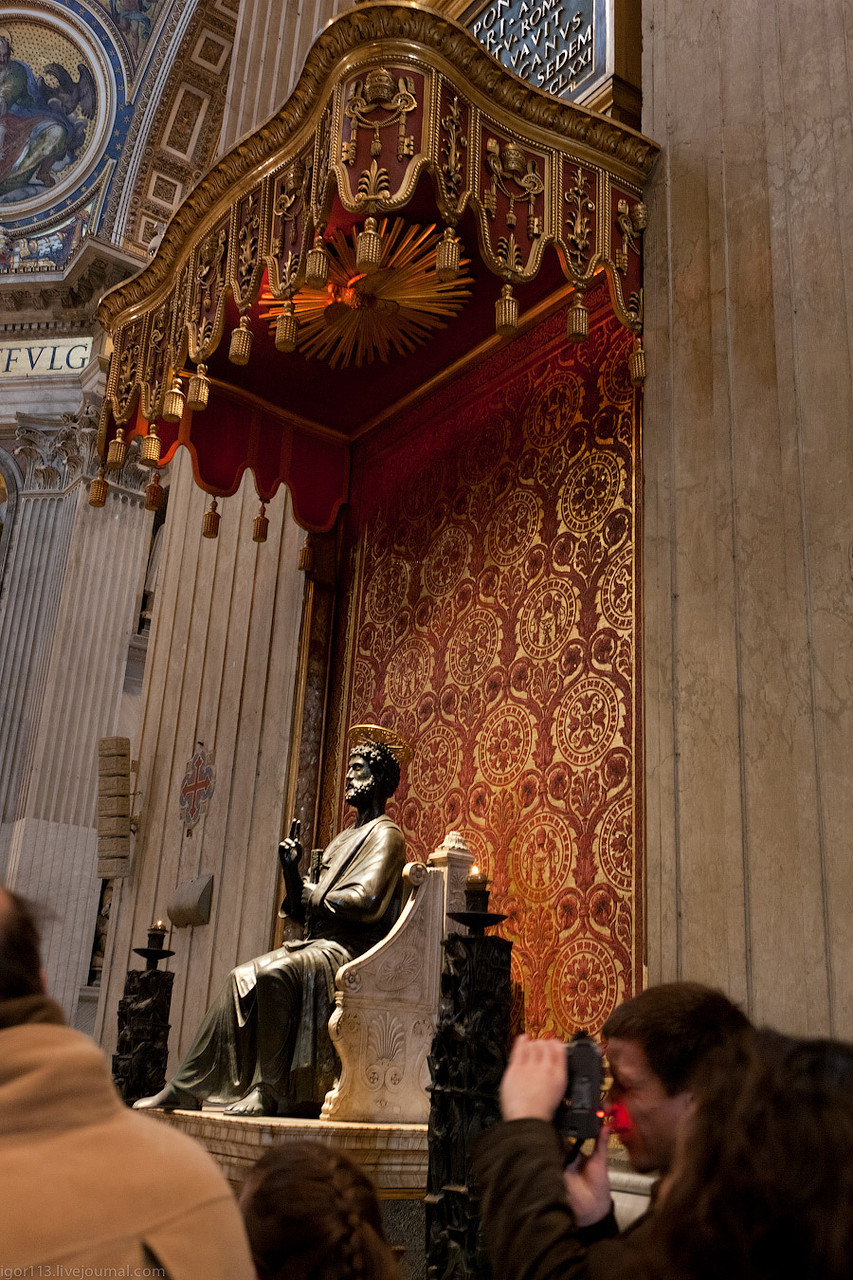
In his left hand, St. Apostle Peter holds the keys to heaven. The wall behind the statue is decorated with mosaics rather than fabric.
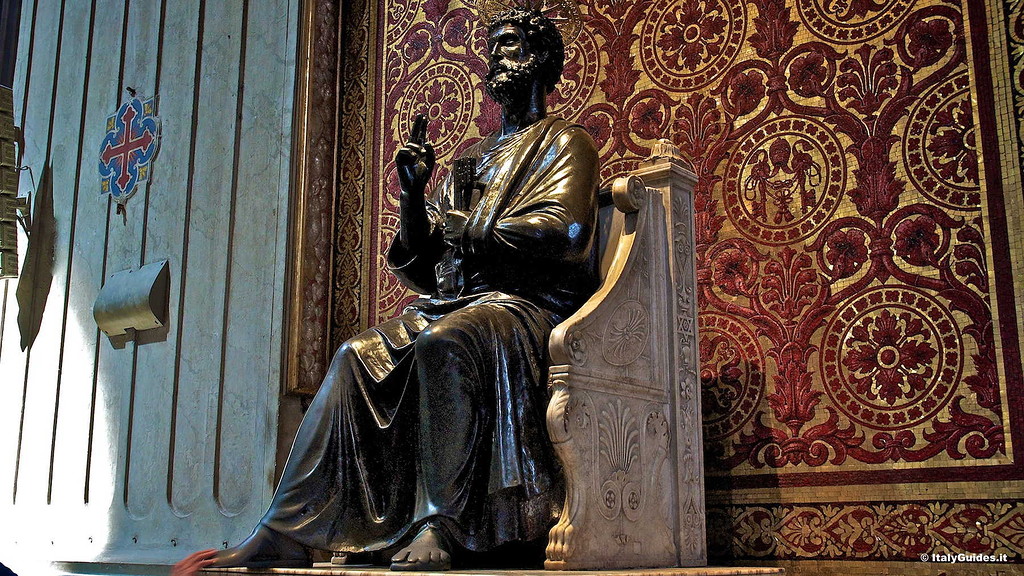
St. Peter led the church for 25 years. For 19 centuries, the only pope who sat on the throne of Peter longer (1847-1878) than Peter himself was Pope Pius IX. His portrait is placed on the wall above the statue of the apostle. The alabaster pedestal was made in 1757 by Carlo Marchionni. The marble chair dates back to the early Renaissance.
On June 29, on the day of remembrance of the Apostle Peter, his statue is dressed in clothes, so that it seems that the statue comes to life.

Throne of St. Peter and Glory

Nave of the basilica
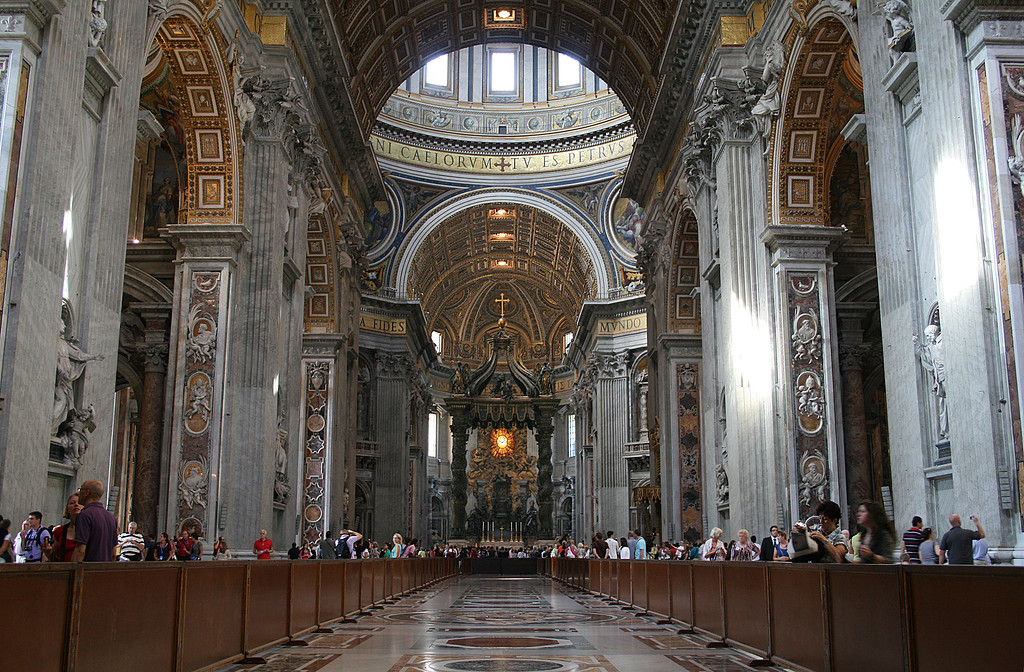
Chair of St. Peter
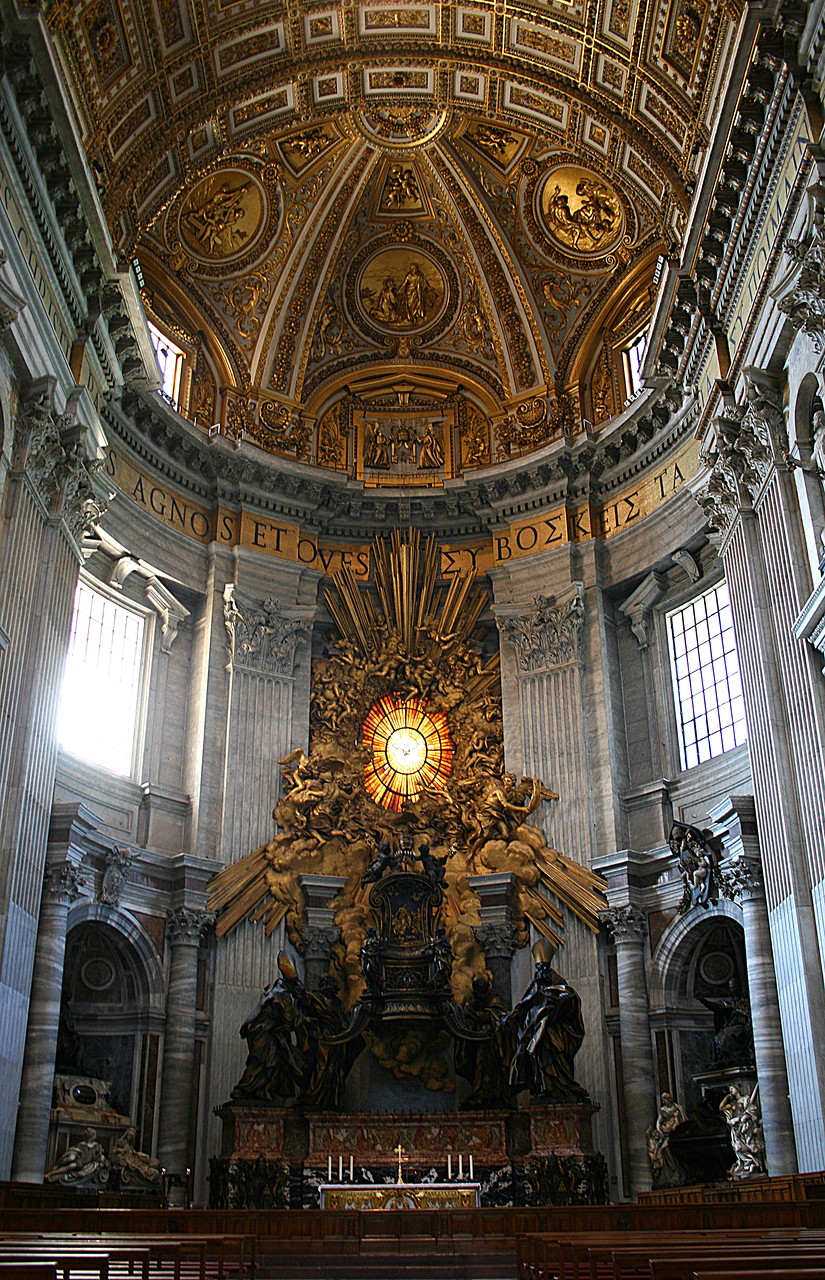
Canopy over the papal altar and the tomb of St. Peter HERE
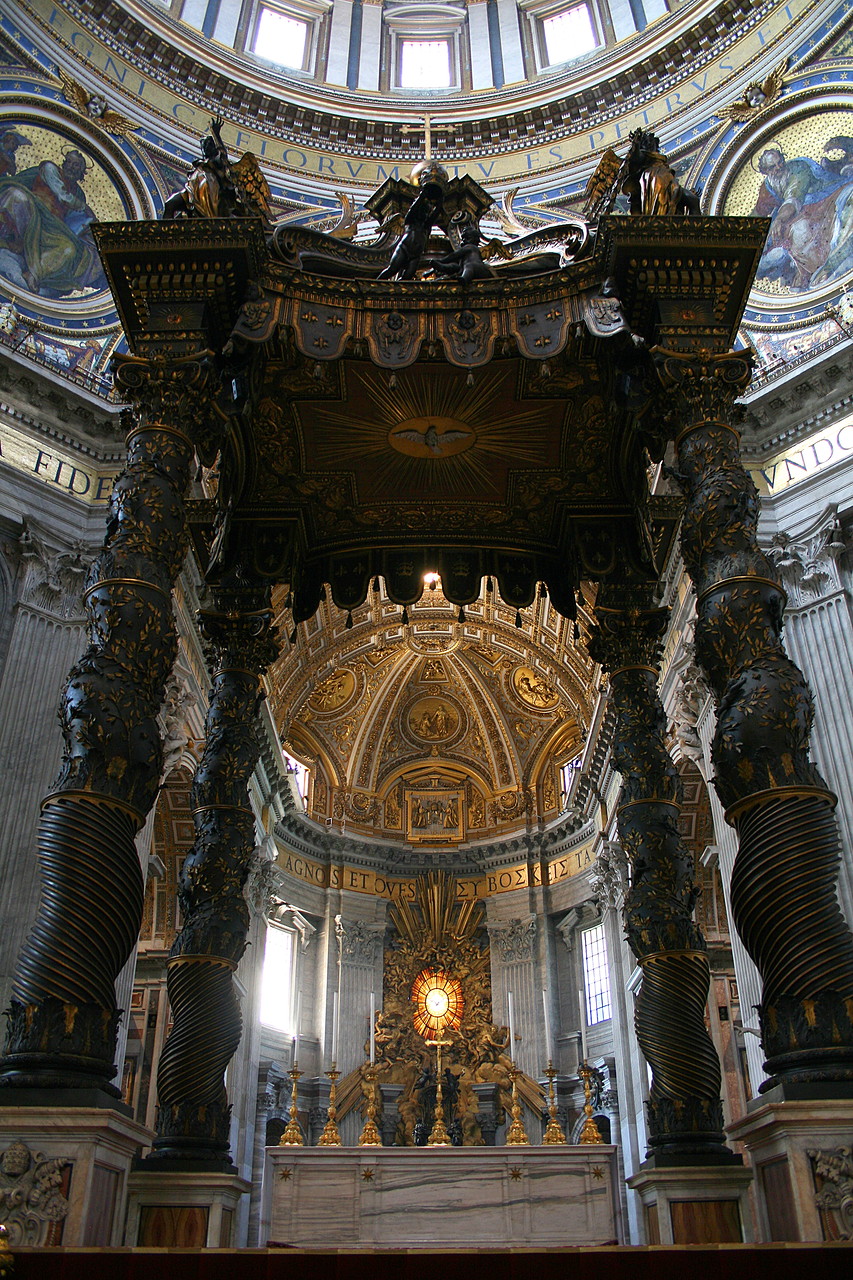
Ciborium (Greek κιβώριον, Lat. ciborium), ciborium, altar canopy - canopy (canopy) over the throne (altar), supported by columns. The plan is most often square and consists of four arches supported by four columns. In icon painting, the image of a ciborium symbolizes the altar.
Altar. It is believed that this is exactly the place where the Apostle Peter was buried. Above the altar there is a thirty-meter ciborium on curved columns, again by Bernini.

The subject of the painting on the Altar is the festive mass of St. Basil in the presence of the Roman Emperor Valens.St.

Under the altar stands a sarcophagus containing the embalmed body of Pope John XXIII.
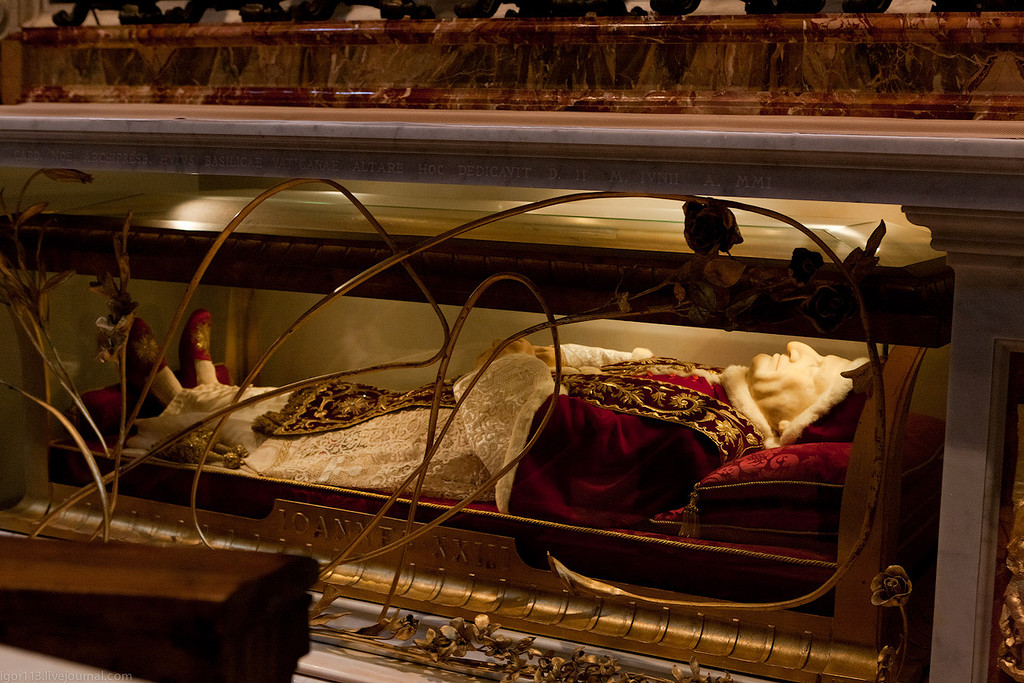
Altar of St. Jerome. Altarpiece "Last Communion of St. Jerome" by the artist Domenichino, 1614. Translated into mosaic in 1744. The famous painting is now kept in the Pinacoteca of the Vatican. The painting depicts St. Jerome receiving last communion from St. Ephraim, who is helped by St. Paula.
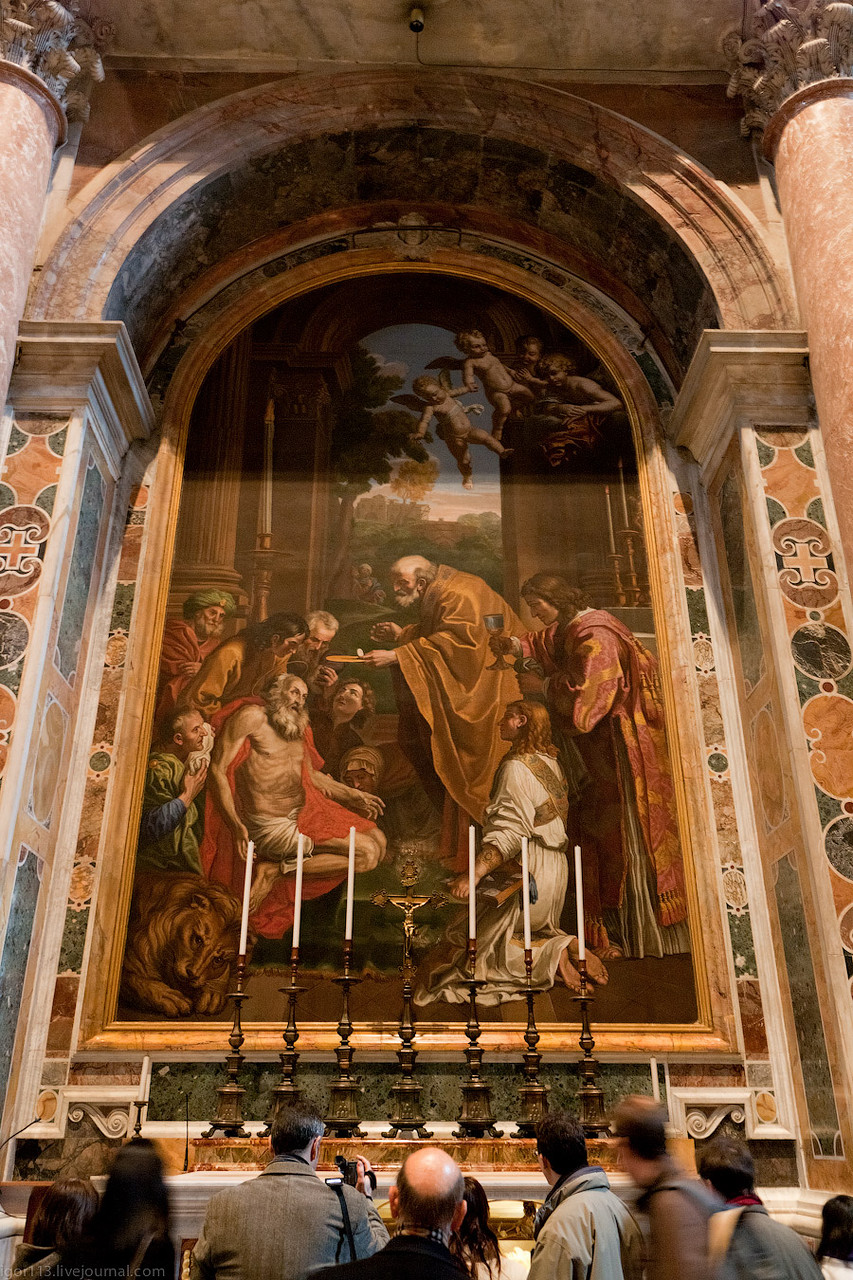
Canopy

In the under-dome space above the main altar there is a masterpiece by Bernini - huge, 29 m high canopy (ciborium) on four twisted columns on which stand statues of angels. Among the laurel branches on the upper parts of the columns are visible the heraldic bees of the Barberini family. The bronze for the ciborium was taken from the Pantheon, having dismantled, by order of Pope Urban VIII (Barberini), the structures that supported the roof of the portico. Through the canopy you can see the Cathedra of St. Peter, located in the central apse and also created by Bernini. It includes the chair of St., supported by four statues of the church fathers. Peter, above which the symbol of the Holy Spirit hovers in radiance.
Soaring in the glow symbol of the Holy Spirit.
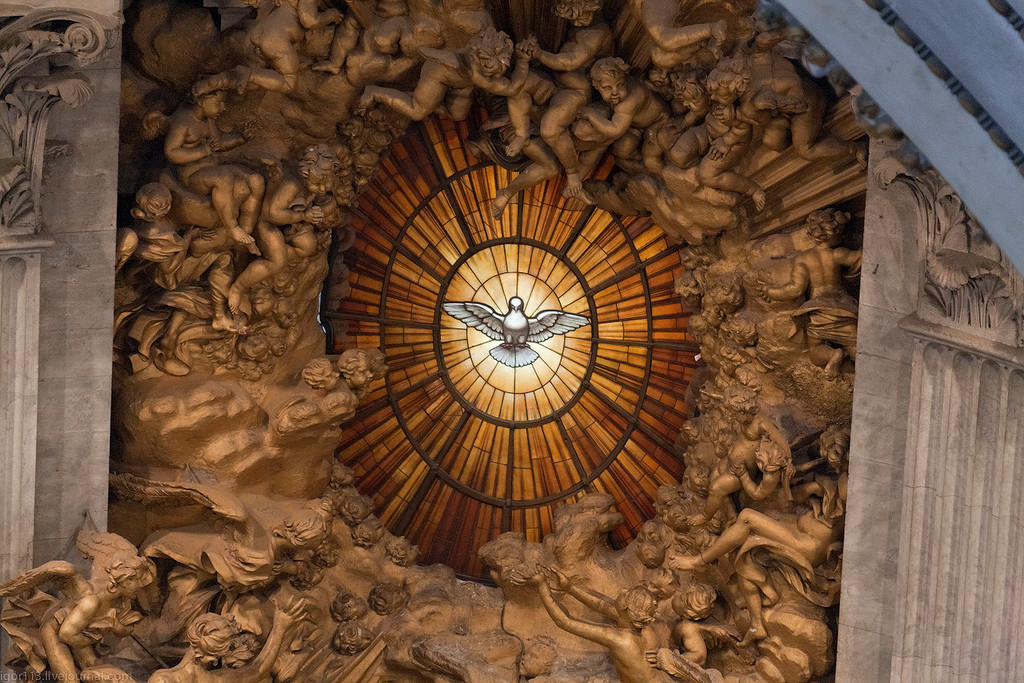

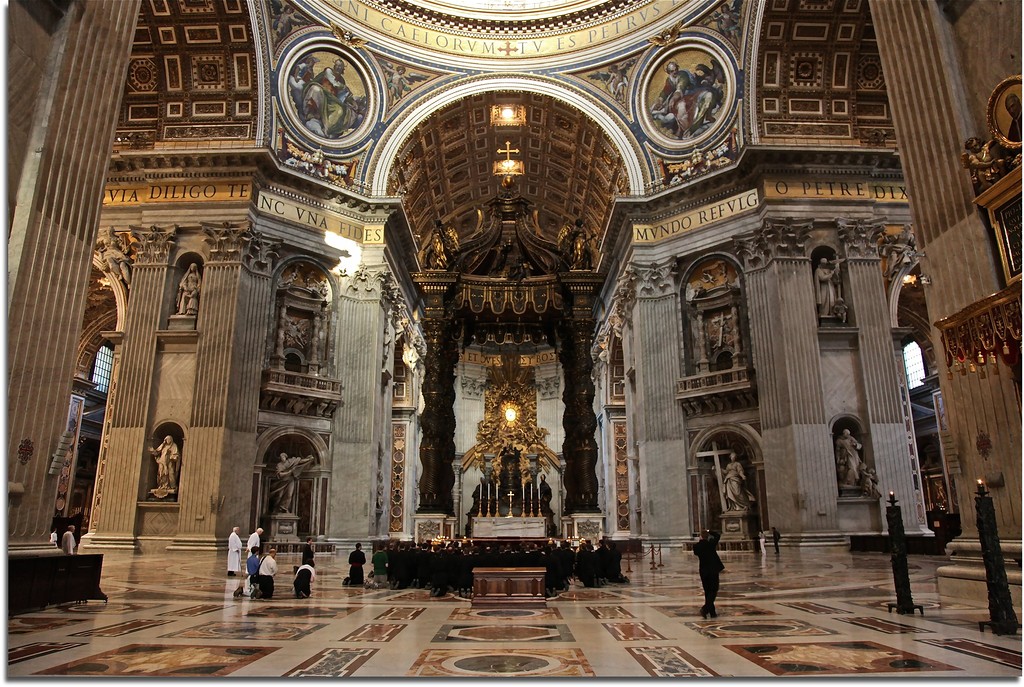
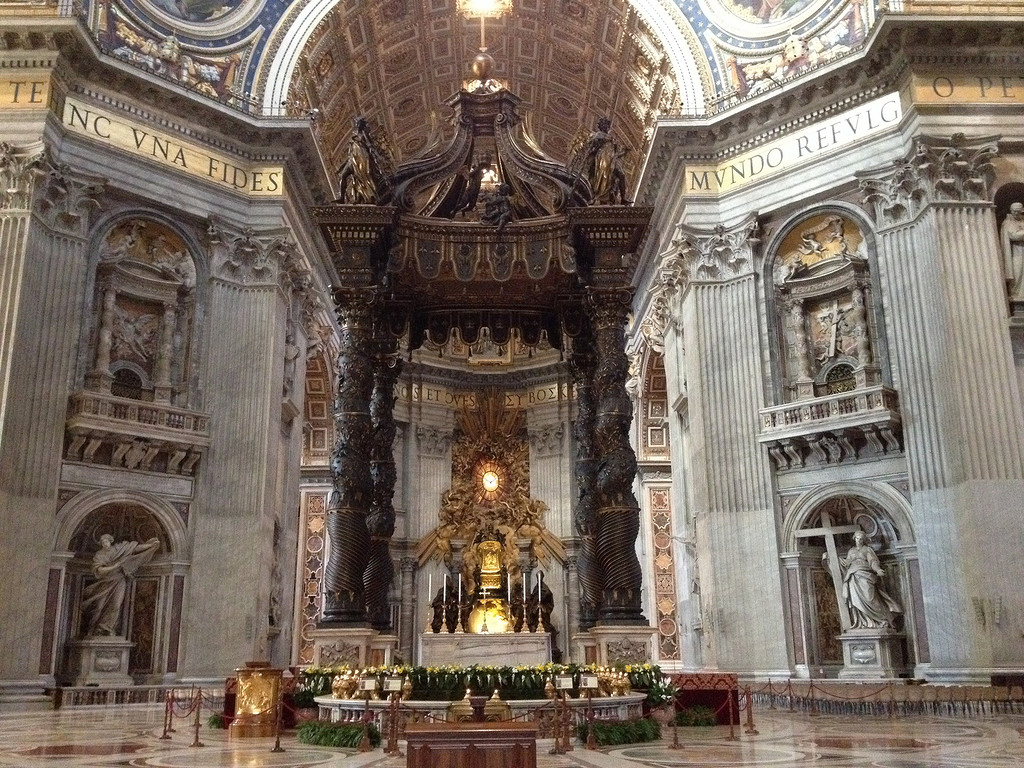
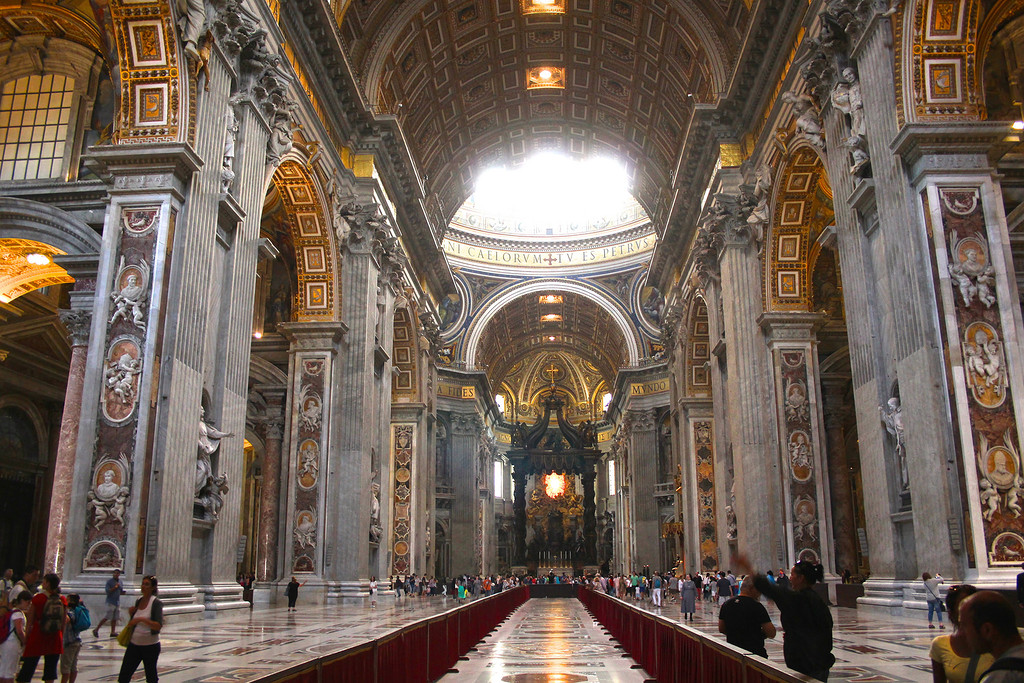
Right nave
In the first chapel of the right nave there is a brilliant creation by the twenty-year-old Michelangelo “Lamentation of Christ” (Pietà) .
The sculpture was carved from a single block of white marble from Carrara, and on the ribbon encircling the Madonna, the sculptor carved the inscription “Michelangelo is a Florentine” .
This is the only work personally signed by Michelangelo.

Michelangelo worked on this creation for more than two years. The sculpture depicts the Blessed Virgin Mary holding her dead son, Christ, on her lap. The beauty of lines perfect proportions Life-size bodies, young faces and the Mother’s grief are so obvious that you want to freeze in silent bow before Michelangelo’s immortal masterpiece.
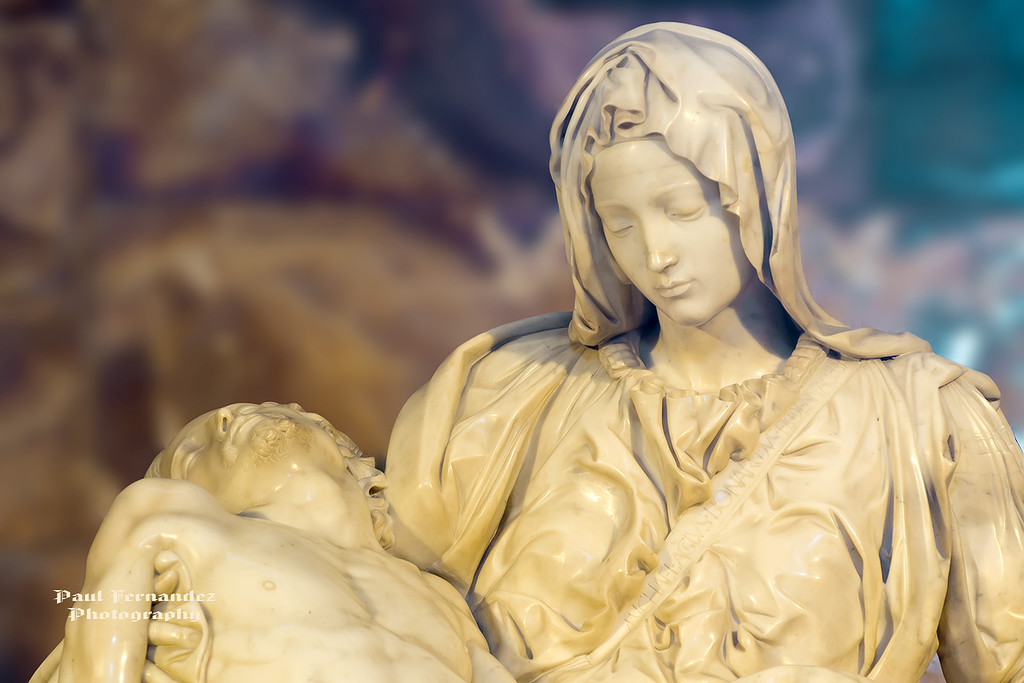
St. Peter's Square in Rome lies in front of one of the most grandiose temples in the world - St. Peter's Basilica. Before the renovations carried out under Mussolini, St. Peter's Square literally stunned everyone who visited it. The Romans, emerging from the narrow streets, where until the last moment the dome of the cathedral was not visible, suddenly found themselves in a huge open space, surrounded on two sides by columns, and on the third by a majestic cathedral façade.
St. Peter's Square is built in the shape of an oval, the dimensions of which are 340 meters in length and up to 240 meters in width. The resulting hemisphere is a symbol of faith, which accepts any person who decides to visit the Church of St. Peter. A wide staircase leads to the basilica; the square is framed on both sides by a colonnade.
Vatican - Bernini's Colonnade
The colonnade in St. Peter's Square was built by the architect Giovanni Bernini in 1656-1667. It consists of 284 Doric columns, distributed in four rows, above which are installed 162 eight-meter sculptures of Catholic saints.
Eat interesting feature at the colonnade. In the center of the square, between the fountains and the obelisk, there are two points marked with white marble. If you stand on one of them, four columns from different rows will merge and only the first columns will be visible and it will seem to you that the colonnade consists of one row of columns. And if you take a step to the side, all the other columns will be visible behind the first one.
Bernini's colonnade was reproduced several times in other countries, so we can see one of the similar structures on Nevsky Prospekt in St. Petersburg - this is the colonnade of the Kazan Cathedral, built at the beginning of the 19th century by the Russian architect Andrei Voronikhin.
Obelisk in St. Peter's Square
The obelisk in the center of the square dates back to the 1st century BC, it was brought from Egypt, from the environs of modern Cairo - Heliopolis for Nero's circus, where it remained for a long time. According to legend, the ashes of Julius Caesar were kept in the ball crowning the monument.
On September 10, 1586, by order of Pope Sixtus V, the obelisk was dragged to the square using a complex device built by the engineer Domenic Fontana. The vehicle performed these difficult maneuvers with the participation of 140 horses. Domenico Fontana warned that any sound could collapse the structure and therefore any word spoken during work was punishable by execution.
At the most crucial moment, the ropes began to weaken and the huge colossus had to fall on its side. But at this time the Genoese sailor shouted: “Water on the ropes!” It was the captain of the ship named Domenico Bresca and he knew very well that when the ropes get wet, they tighten.
The 25.5 meter high obelisk was rescued and successfully installed, and Captain Bresque was summoned to the Pope. According to legend, he praised the captain and asked how he could thank him. The captain's request was modest - he asked permission to bring palm branches to the Vatican on Palm Sunday, preceding Easter.
The height of the obelisk, together with the pedestal and cross on top, is 41 meters.
However, the ashes of Julius Caesar were never discovered during these works. The ball was placed in the Vatican Museums, and a cross was installed on the obelisk.
Next to the obelisk there are two 17th-century fountains by Maderna and Bernini.
St. Peter's Square today
On Sundays and holidays everyone who wants to hear the Pope's sermon gathers here. The square is filled with chairs and those who come listen to the speech of the head of the Catholic Church in 20 languages. At exactly noon, the Pope delivers his speech from the balcony above the main entrance to the basilica or from the windows of his office, which are located on the left edge on the top floor of the building located behind the colonnade on the right.
There is one more opportunity to see dad. He holds a general audience on Wednesday at 10 a.m. True, if you don’t take a seat in advance, you won’t see anything except backs and cameras.
The rest of the time, St. Peter's Square is full of tourists who come to the museum. At the same time, we must not forget that no frivolity in clothing is allowed here. If you are not dressed appropriately, it is better to immediately buy a T-shirt with sleeves or some kind of cape-scarf at the souvenir kiosk along the way.
The grandiose St. Peter's Square attracts thousands of tourists every day. It was located right next to the Catholic one (as planned by one of the pontiffs). This amazing place has become a historical and Christian value. Two semicircles of the square, and in the center a forty-meter obelisk from a bird's eye view, resemble a keyhole. Along the contour of the semicircles there are small connected columns that became the frame. And a little further, beyond their borders, is written white line. It’s strange, but almost no one pays attention to it, although it is a fairly important government drawing. What does it mean? The state border that separated Rome from the Vatican.
History of creationAt that time, instead of St. Peter's Square in the Vatican there were beautiful gardens and the Circus of Nero. The Apostles Peter and Paul were executed in a large circus. Nero decided to perpetuate his famous circus and turned to the scandalous Caligula. It was he who brought the forty-meter obelisk from Egypt to the Vatican. This required more than one hundred workers and a dozen chariots. In the end, in the fourth century, Caligula was able to cope with his task and delivered the obelisk to the Vatican in St. Peter's Square. Initially, he stood in the very center of the circus. Nero wanted this wonderful building of his to be visible from anywhere in the Vatican, and, accordingly, in Rome. The obelisk in St. Peter's Square was the only one of the 13 that has survived to this day.
In the sixteenth century, not a trace remained of Nero's circus and gardens. The square at that time was a large rectangular space. It was filled with soil, so during rains the area turned into a viscous swamp. Pope Julius II began construction of the majestic cathedral, so the area in front of him spoiled the whole picture. Pope Six the Fifth helped Julius cleanse the obelisk and the space itself from filth, and then the square began to be put in order. The famous St. Peter's Square in the Vatican was designed by Lorenzo Bernini, who was able to perfectly connect it with the facade of the cathedral.
Sunday SquareA considerable number of tourists and Catholics gather in St. Peter's Square in the Vatican every Sunday. What is it that attracts them so much? Everyone is waiting for the Pope to appear. Every Sunday at 11.00 the Pontiff appears on the balcony of St. Peter's Basilica to bless the people and pilgrims. After the blessing, he reads the prayer “Angel of the Lord” with everyone. Such reading evokes delight and an incredible feeling of unity among everyone who attends the event. If the weather is rainy outside, the meeting and prayer reading takes place in the cathedral hall. Unfortunately, not everyone can get there, because the hall is designed for only 3,000 people and entry is only by tickets. Now they cost 12 euros and it is impossible to get them for the next Sunday, there are too many people who want them. You can buy tickets at the entrance to the cathedral on any weekday, or on the website www.selectitaly.com. For those who were unable to attend the pope's ceremonial audience, there is a live broadcast on a huge monitor on the outside of the cathedral.
FountainsIn St. Peter's Square in the Vatican you will see two wonderful fountains. They were created in completely different eras and by different famous authors, but at the same time they look like twins. The fountain, which is located on the left side of the square (if you stand with your back to the cathedral), was erected in 1614. This creation brought fame and recognition to the architect Carlo Moderno. The design of the fountain was the very first in Rome, quite unusual and at the same time delightful. In 1667, Gian Lorenzo Bernini was able to repeat the master’s work and created a second similar fountain, only on the right side of the square. This added some symmetry to the space. Both fountains simply fit perfectly into the baroque style of the cathedral and add a certain harmony to St. Peter's Square.
How to get there?St. Peter's Square in the Vatican is quite easy to get to. You should take bus number 64 and get off at the Largo Di Porta stop. After getting off the bus, you will need to go up a block in a northerly direction. The obelisk on the square will become a kind of landmark for you at this moment, so you definitely won’t get lost. It is, of course, easier to get there by your own car. Via della Conciliazione will take you to your destination.
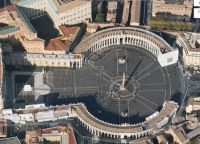 |
 |
 |
 |
 |
 |
St. Peter's Basilica is a Catholic cathedral that is the most large structure Vatican and until recently considered the largest Christian church in the world.
White tent shining in the blue sky of Rome - dome St. Peter's Basilica, the main temple of the Catholic world. A temple that is more than five centuries old...
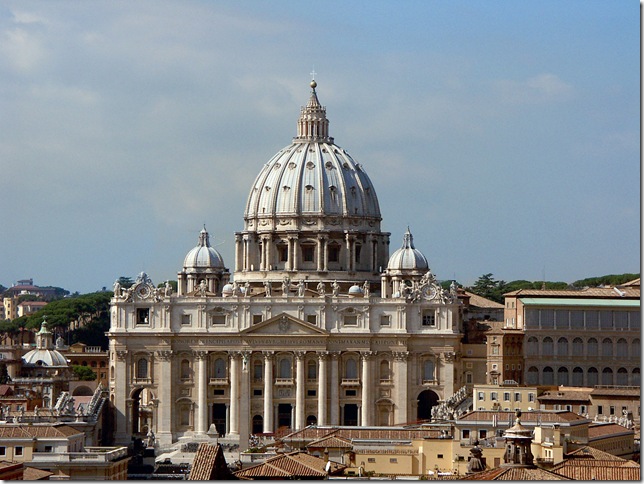
St. Peter's Basilica is located west of the center of Rome, within the sovereign state of Vatican City. History tells that on the site of the present St. Peter's Cathedral there was a circus, in the arena of which Christians were martyred during the time of Nero. In 67, the Apostle Peter was brought here after the trial. Peter asked that his execution not be compared to Christ’s. Then he was crucified head down. In 326, in memory of this, Emperor Constantine ordered the construction of a basilica in the name of St. Peter. When it fell into disrepair, Pope Nicholas V began construction of the cathedral in 1452. After his death, work was suspended, and only in 1506 did Pope Julius II commission the architect Bramante to build the cathedral. Bramante conceived the church in the form of a Greek equilateral cross. Almost all the major architects of Italy took turns participating in the design and construction of St. Petra. After Bramante's death, the work was entrusted to Raphael, who redesigned the church in the form of a Latin cross. Then the construction of the cathedral was led by Michelangelo. Michelangelo made all the supporting structures more massive and highlighted the main space. He erected the drum of the central dome, but the dome itself was completed after his death. Architects Giacomo della Porta and Domenico Fontana, based on Michelangelo's design, erected two domes: an internal, rounded one, and an external, elongated one. Carlo Maderno completed the longitudinal chapels and designed the façade of the cathedral. Of the four small domes envisaged by Michelangelo's design, the architect Vignola erected only two. To the greatest extent, the architectural forms exactly as they were conceived by Michelangelo have been preserved on the altar, western side. On November 18, 1626, on the 1300th anniversary of the first basilica and 120 years after construction began, Pope Urban VIII consecrated the new cathedral.
But the story didn't end there. At the beginning of the 17th century. At the direction of Paul V, the architect Carlo Maderno lengthened the eastern branch of the cross - he added a three-nave basilica part to the centric building, thus returning to the shape of the Latin cross, and built a facade. As a result, the dome turned out to be a hidden façade, lost its dominant meaning and is only perceived from a distance, from Via della Concigliazione.
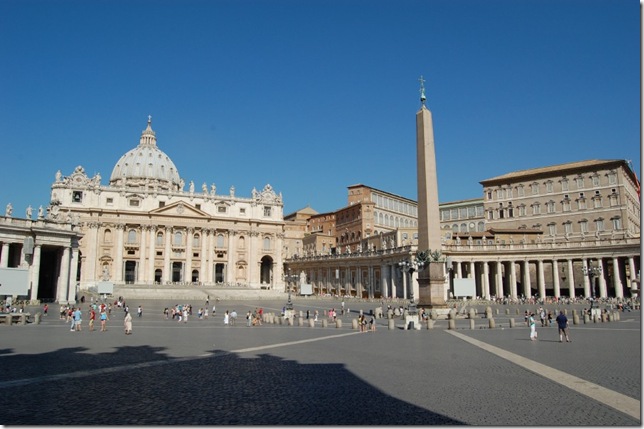
A square was needed that could accommodate the large number of believers who flocked to the cathedral to receive papal blessings or take part in religious celebrations. This task was completed by Giovanni Lorenzo Bernini, who created in 1656-1667. The square in front of the cathedral is one of the most outstanding works of world urban planning practice. He also created a magnificent interior decoration and the famous canopy over the tomb of the apostle, whose name the cathedral bears. The colonnade framing the cathedral square is also his creation.
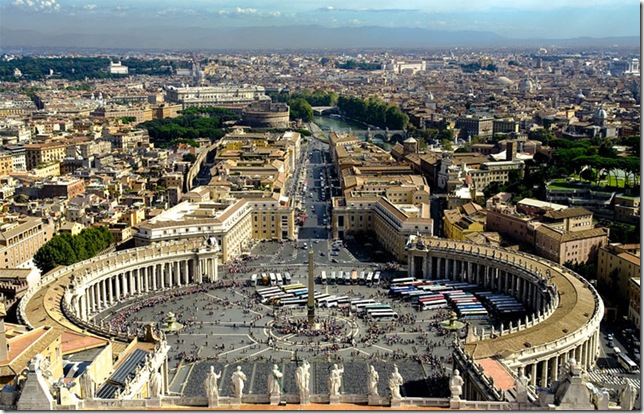
View from the cathedral to the square

A new altar was erected in the place of the previous one and a “window” was cut into the floor - a “confession box”, through which believers could see the tomb of St. Peter, hidden underground. Excavations carried out in the 1940s proved that the tomb of the apostle was located under the altar of the cathedral. This was evidenced by numerous facts, including inscriptions and images. Altar of the Cathedral of St. Petra faces west, not east, as in most Christian churches.
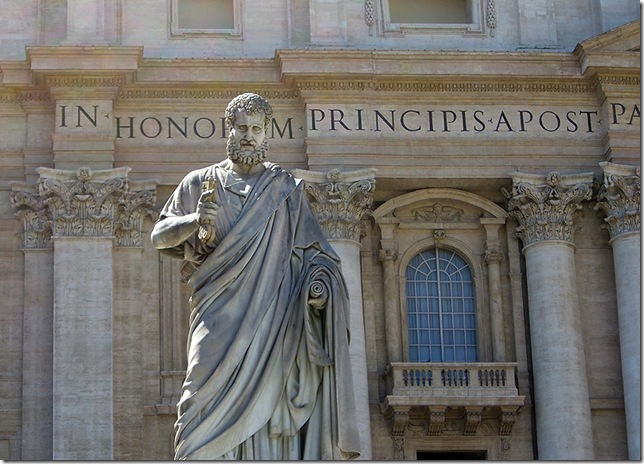
In front of the entrance to the cathedral there are statues of the Holy Apostles Peter and Paul. Peter holds in his hands the keys to the Kingdom of Heaven, handed to him by the Lord. There are five doors leading into the cathedral. The last one on the right side is the Holy One, and it opens only in the Holy Year. In ancient times, the beginning of the jubilee year was marked by the sound of a goat's horn trumpet called “yobel”, hence the word “jubilee”. The holy door is walled up with concrete. Every 25 years, on Christmas Eve (December 25), the concrete is broken before the anniversary year. After three kneelings and three blows of the hammer, the Holy Door swings open and the pope, taking the cross in his hands, is the first to enter the cathedral. At the end of the Jubilee Year, the door is closed again and sealed for the next 25 years.
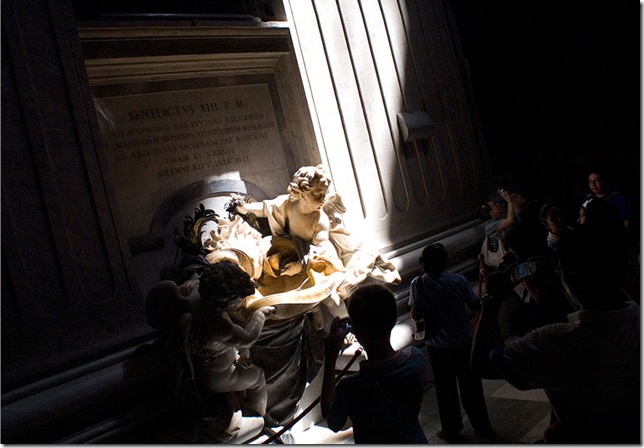
The bronze doors of the central entrance were made by the Florentine master Filaret. At the top of the doors there are large figures of the Savior and the Mother of God sitting on the throne. In the center are the apostles Peter and St. Paul. The two lower hallmarks depict scenes of the trial of Nero and the subsequent execution of the apostles: the beheading of St. Paul and the crucifixion of St. Peter. Above the doors is a marble bas-relief by Bernini “Jesus Entrusting Peter with the Keys of the Kingdom of Heaven.”

The dome, an architectural masterpiece, has a height of 119 m inside and a diameter of 42 m. It is supported by four powerful pillars. In a niche of one of them there is a five-meter statue of St. Longina by Bernini. Bernini's role in the creation of the sculptural decoration of the cathedral is very great; he worked here intermittently for almost fifty years, from 1620 to 1670. In the dome space above the main altar there is Bernini's masterpiece - a huge, 29 m high canopy on four twisted columns, on which there are statues of angels.
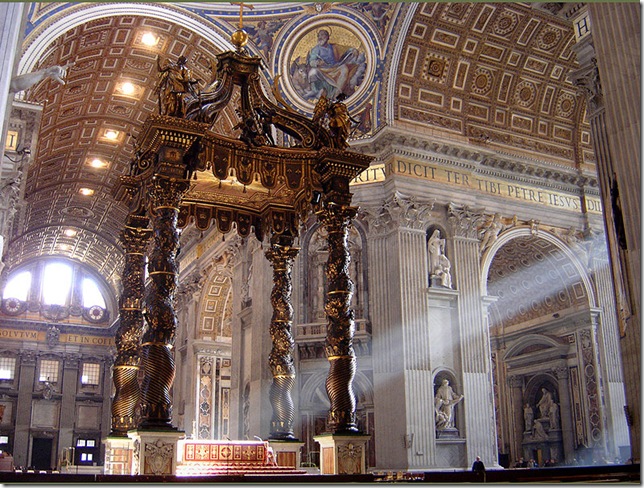
Among the laurel branches on the upper parts of the columns are visible the heraldic bees of the Barberini family. The bronze for the ciborium was taken from the Pantheon, having dismantled, by order of Pope Urban VIII (Barberini), the structures that supported the roof of the portico. Through the canopy one can see the Cathedral of St., located in the central apse and also created by Bernini. Petra. It includes the chair of St., supported by four statues of the church fathers. Peter, above which the symbol of the Holy Spirit hovers in radiance. To the right of the pulpit is the tombstone of Pope Urban VIII by Bernini, to the left is the tombstone of Paul III by Guglielmo della Porta, one of Michelangelo’s students.
![]()
Huge dome St. Peter's Basilica flies up like a light sheet lifted by the wind.

Along the frieze of the dome and further along the frieze of the entire church there is a mosaic inscription in Greek and Latin with the words of Christ: “You are Peter, and on this stone I will build My Church, and the gates of hell will not prevail against it; And I will give you the keys of the Kingdom of Heaven; and whatever you bind on earth will be bound in heaven; and whatever you permit on earth will be permitted in heaven.”
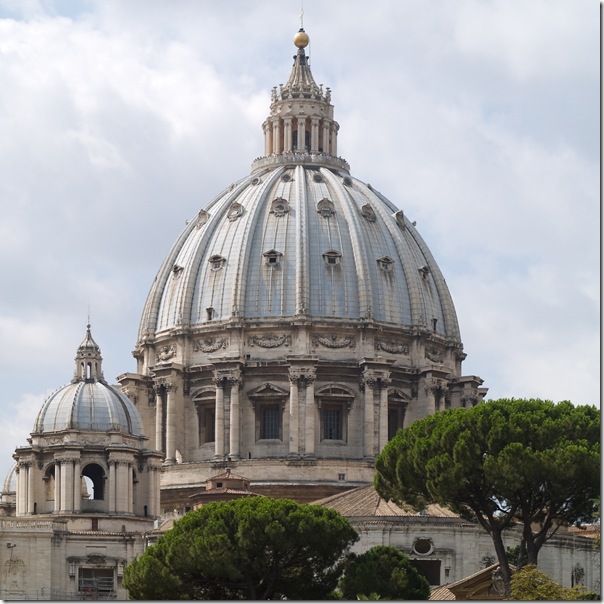
The inner surface of the dome is decorated with images of the four Evangelists: Matthew - with the angel who led his hand while writing the Gospel, Mark - with the lion, Luke - with the ox, John - with the eagle. The lion, eagle and ox are called “apocalyptic beasts”, which John the Theologian writes about in the “Apocalypse” as animals that surrounded the throne of God.

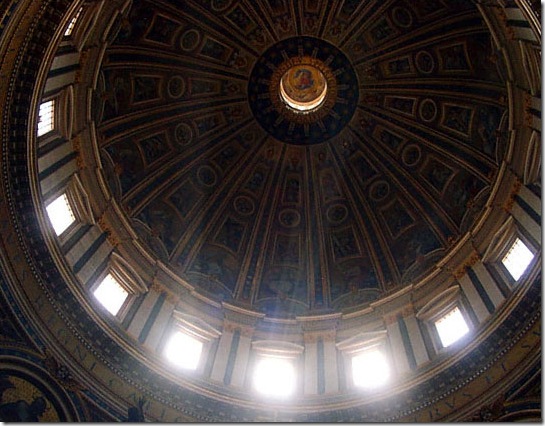
The height of the facade is 45 m, the width is 115 m. The attic of the facade is crowned with huge, 5.65 m high, statues of Christ, John the Baptist and the eleven apostles (except for the Apostle Peter). From the portico, five portals lead to the cathedral.
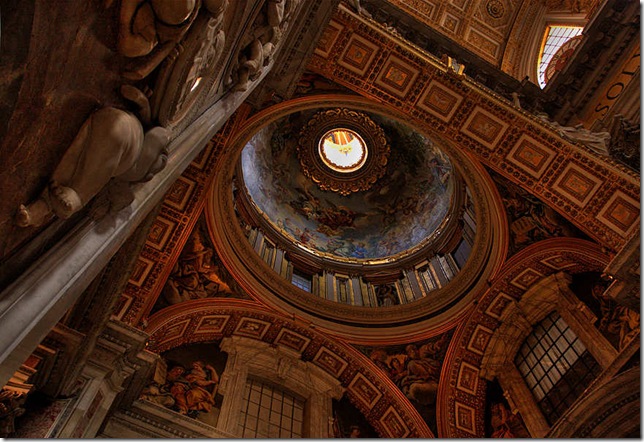
The doors of the central portal were made in the middle of the 15th century. and come from the old basilica. Opposite this portal, above the entrance to the portico, is a famous mosaic by Giotto from the late 13th century. "Navichella". The reliefs of the leftmost portal - the “Gate of Death” - were created in 1949-1964. by the great sculptor Giacomo Manzu. The image of Pope John XXIII is very expressive.
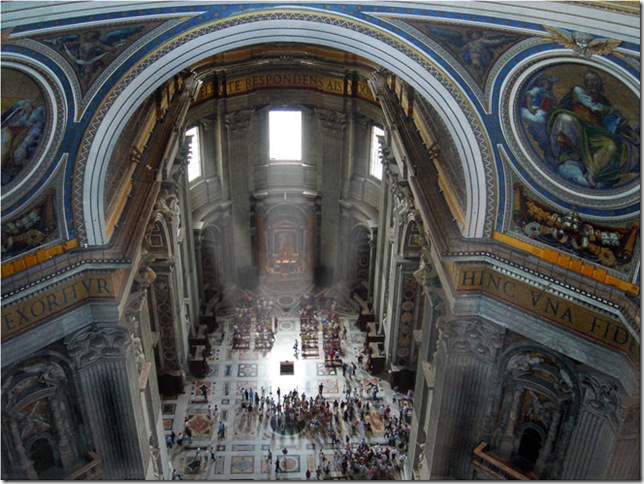
Inside, the cathedral amazes with its harmony of proportions, its enormous size, and the richness of its decoration - there are a lot of statues, altars, tombstones, and many wonderful works of art. The total length of the basilica is 211.6 m. On the floor of the central nave there are marks showing the dimensions of other largest cathedrals in the world, which allows them to be compared with the largest, the Cathedral of St. Petra.
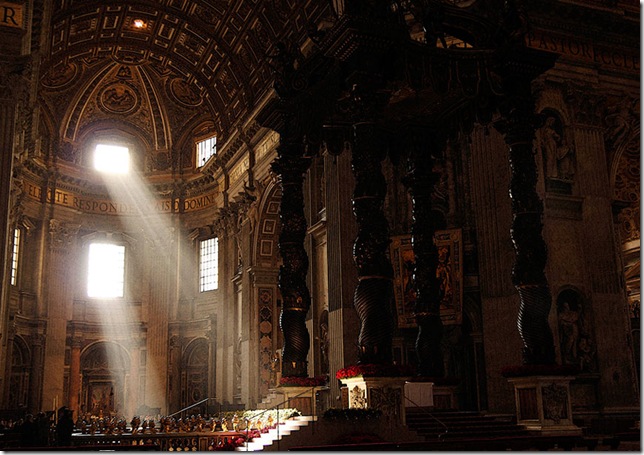
In the center of the cathedral stands an altar with unquenchable lamps. The altar is called the papal altar because only the Pope can celebrate Mass in front of it. Nearby is a bronze figure of St. Peter sitting on the papal throne and holding in his hand the keys to the Kingdom of Heaven. The apostle’s feet have already turned white and worn away from the touches of believers: according to legend, if you make a wish and, holding Peter’s foot with your hand, ask with faith for the fulfillment of your plans, then everything will certainly come true.
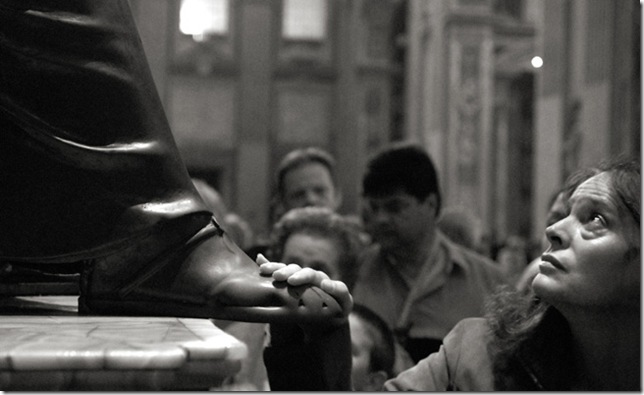
In the first chapel on the right there is Michelangelo's masterpiece - the marble Pieta. It was created by him at the turn of the 15th and 16th centuries at the age of 25. After the attacker attempted to break the statue, it was protected with glass.

Nearby is the small Chapel of the Crucifixion, which houses a magnificent wooden crucifix from the late 13th to early 14th centuries, attributed to Pietro Cavallini. A little further is the tombstone of Margravine Matilda of Canossa by Bernini with his students; she was the first woman to receive the honor of being buried in this cathedral.

Grille of the Chapel of St. The communion is made according to a drawing by Borromini. Next to the chapel is the tombstone of Gregory XIII; The bas-relief recalls the reform carried out by the pope - the introduction of a new, Gregorian, calendar. A little further is the tombstone of Clement XIII, made in the neoclassical style by the sculptor Canova. Of great interest is the work created in the 1490s. The tombstone of Innocent VIII by the sculptor Antonio Pollaiolo is one of the few surviving monuments that were still in the old basilica. Not far from the entrance you see another creation by the sculptor Canova - the tombstone of the last representatives of the Scottish royal Stuart family.
Along the entire perimeter of the cathedral there is a string of chapels, where there are outstanding works of art, precious relics of Christianity, and numerous tombs of popes, kings and emperors. In the cathedral sacristy there is a marble plaque with the names of all the high priests buried in the cathedral, starting with the first - the Apostle Peter. The numerous tombstones of the popes installed in the cathedral are mostly works of art made by great masters - Giotto, Bernini, Michelangelo, Guglielmo della Porta, Thorvaldsen. The cathedral contains the Spear of the centurion Longinus - the same one with which the Savior was pierced on the cross. It came to Rome from Constantinople. One of the chapels contains part of the relics of the Archbishop of Constantinople, St. John Chrysostom.
Until 1990, St. Peter's Basilica in Rome was the largest Christian church in the world (in 1990 it was surpassed by the cathedral in Yamoussoukro, the capital of the African state of Cote'd Ivoire - former Ivory Coast). The size of the cathedral is amazing. It covers an area of 22067 square meters. The height of the cathedral is 133 meters, the length with the portico is 211.5 meters. By the way, the world's largest Christian church- the same Basilica of Notre-Dame de la Paix in Yamoussoukro - built on the model of St. Peter's Cathedral.

In 2007, the last work of Michelangelo Buonarotti, completed shortly before his death, was found in the Vatican archives. This is a red chalk sketch of a detail of one of the radial columns that make up the drum of the dome of St. Peter's Basilica in Rome.
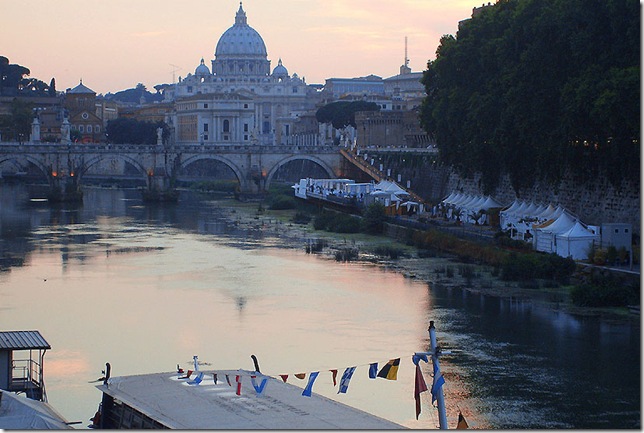
St. Peter's Basilica has become a symbol of the power of the Catholic Church. But it also became a model whose features are recognizable in all major temple buildings of all Christian countries in subsequent centuries.

A couple more night views of St. Peter's Basilica



Saint Paul's Cathedral - one of the most famous landmarks in Italy, it is located in the western part of Rome, on the territory of the Vatican enclave, which is an independent state. In ancient times, there was a circus on this site, where gladiator fights were held, and Christians were martyred to the enthusiastic cries of the crowd. And construction Catholic Cathedral at this place is a symbol of the victory of Christianity over paganism. In the year 67, the Apostle Peter was crucified at this very place, but, in accordance with his requests not to compare his execution to the death of Jesus Christ, Peter was crucified upside down.
Vatican, St. Peter's Basilica - one of the most famous landmarks in Italy, it is located in the western part of Rome, on the territory of the Vatican enclave, which is an independent state. In ancient times, there was a circus on this site, where gladiator fights were held, and Christians were martyred to the enthusiastic cries of the crowd. And the construction of a Catholic cathedral on this site is a symbol of the victory of Christianity over paganism. In the year 67, the Apostle Peter was crucified at this very place, but, in accordance with his requests not to compare his execution to the death of Jesus Christ, Peter was crucified upside down. The basilica, named after St. Peter, was erected on this very site, it was erected in 326 by order of Emperor Constantine. This basilica stood for more than ten centuries, but it also fell into disrepair.
In 1452, during the reign of Pope Nicholas V, construction of St. Peter's Cathedral began on the site of the old basilica, but after the death of the bishop, all work on the construction of the temple was suspended. And only half a century later, Pope Julius II decided to continue construction work and ordered new project temple to the famous architect Bramante. It was decided to build a new cathedral in the shape of a Greek equilateral cross, but the architect died and the church was never built. The further design of the temple was already developed by Raphael, who decided to replace the Greek cross with a Latin one. And later the construction of St. Peter's Cathedral was carried out by Michelangelo Buonarotti, who designed the domes of the cathedral. The plan was achieved only after his death, and construction was already underway under the leadership of the architects Giacomo della Porta and Domenico Fontana. Both domes were completed - the inner dome, round in shape, and the outer dome, stretched upward, as if reaching into the heavens. The construction of the temple was completed by the architect Carlo Maderno, at which time the chapels were built and the decorative design of the facade was completed. St. Peter's Basilica was only consecrated on November 18, 1626 by Pope Urban VIII, which marked the 1,300th anniversary of the founding of the original basilica.
The altar of St. Peter's Basilica was installed in the same place as the altar of the first basilica, and a window was specially cut into the floor of the temple, which was called the “confessional room”. Through it, believers and clergy could look into the place where the coffin with the ashes of the Apostle Peter was located underground. In the 40s of the twentieth century, excavations were carried out in this place, confirming that the remains of Peter were in the coffin; inscriptions, drawings, and other artifacts testified to this.
For many years, St. Peter's Cathedral was the tallest temple in the world; its size is stunning in its scope - a masterpiece of sacred architecture occupies a huge area of 22,067 square meters. m., it rises 189 meters high, and its width is 211 meters, including the portico. And only in 1990, in the African country of Cote d'Ivoire, located in the Ivory Coast region, another christian temple, the height of which exceeds the dimensions of St. Peter's Basilica in the Vatican. But after Yamoussoukro Cathedral, the Vatican Temple remained one of the tallest cathedrals in the world.
At the entrance to the cathedral you can see two grandiose sculptures, one of them depicts the Apostle Peter, the other - the Apostle Paul. Saint Peter holds the keys in his hands, symbolizing the entrance to heaven; it is believed that the keys to the Heavenly Kingdom were given to him by God himself. You can get inside the cathedral by passing through one of five doors; on the right side there is also a “Holy” door, which opens only for one year every quarter of a century. It has another name - “anniversary”. And the word “yobel” itself is the name of the goat’s horn, which in ancient times marked the beginning of the holy year. This door is walled up with concrete, and it is broken only in the anniversary year on the eve of the Nativity of Christ, held according to Catholic tradition on December 25. The Pope kneels three times before entering through the “holy” door, and then hits the remaining concrete with a hammer three times, and only then can he enter inside. The year of jubilee ends, and the holy door is again concreted and remains in this form for the next quarter century.
The bronze doors of St. Peter's Basilica in the Vatican are also of interest; the famous master from Florence, Filaret, who lived in the 15th century, worked on them for a long time. At the top of the doors are depicted Jesus Christ and the Virgin Mary seated on a gilded throne, in the central part of the composition are the apostles Peter and Paul, and below are scenes of the crucifixion of the holy apostles. And looking up, you can see the bas-relief “Jesus Entrusts Peter with the Keys of the Kingdom of Heaven,” made of marble by the master Bernini. The decoration of the cathedral took place over several centuries, and only the best masters of art of their time took part in the decoration, decorating the walls and vaults of the temple with numerous mosaic images. In St. Peter's Basilica there is also a sculptural composition made by Michelangelo, called “Lamentation of Christ.”
Majestic dome The cathedral soars into the sky like a light canvas or sail, and the visitor to the temple has a feeling of the lightness of the entire structure, although the size of the dome in diameter is 42 meters, for which the inhabitants of Rome call it the word “dome”. The dome itself, as well as the frieze of the temple, like a thin memorial fly, is surrounded by a mosaic inscription from the Gospel. It reads: “You are Peter, and on this rock I will build My Church, and the gates of hell will not prevail against it; And I will give you the keys of the Kingdom of Heaven; and whatever you bind on earth will be bound in heaven; and whatever you permit on earth will be permitted in heaven.” These words are attributed to Jesus Christ, on their basis the Apostle Peter is considered the first Pope of Rome, and all subsequent rulers of the Catholic Church consider themselves vicars of St. Peter. On the inside, the grandiose dome is decorated with the image of the evangelists - John, Mark, Matthew and Luke. Next to each is a symbolic animal mentioned in the Apocalypse written by John the Theologian - a lion, an ox and an eagle, and only next to Matthew is an angel. According to Catholic tradition, in the Gospel of Matthew, all the letters were written by the angel himself, holding the hand of the writing apostle.
Altar is located in the center of the cruciform cathedral; at any time of the day there are lit lamps on it that do not go out. Only the Pope himself has the right to conduct services in front of this altar, which is why the altar received the name papal. And nearby there is a sculptural composition made of bronze, it depicts the Apostle Peter seated on the throne. According to an ancient belief, if you bow to the apostle and touch his feet, even your deepest secret desire will come true, so Peter’s bronze feet have long been worn out, and the color, as if of polished bronze, is very different from other parts of the sculpture.
Numerous internal chapels built around the entire perimeter of the cathedral give the temple a special sophistication, lightness and originality. And inside them are stored priceless masterpieces, paintings and sculptures, holy relics, as well as tombs in which the ashes of the leaders of the Catholic Church, Roman emperors and Italian kings rest. The names of all the clergy and dignitaries buried in St. Peter's Cathedral can be found by visiting the sacristy; they are imprinted in stone - engraved on a marble plaque. The tombstones of the popes, which can be seen in the cathedral, were made by outstanding masters of their time - Giotto and Thorvaldsen, Bernini and Guglielmo della Porta, as well as the great Michelangelo.
The main relic of St. Peter's Cathedral in the Vatican can be called one that belonged to the Roman centurion Longinus, it was the one that pierced the body of Jesus Christ crucified on the cross, this relic was brought to the Vatican from the capital of the Byzantine Empire - Constantinople, another important relic is the relics of St. John. One of the chapels, called the “Chapel of Baptism,” is also of interest, the altar of which is decorated with a mosaic image of the Baptism of the Lord. And the baptismal font for infants is made from the lid of the coffin of the German emperor Otto II, who lived in the 10th century; his ashes also rest in the cathedral. The best mosaic image of St. Peter's Basilica is considered to be the mosaic "Funeral of St. Petronilla", made as a copy of a painting by the famous artist Guercino. It can be seen by visiting the Chapel of St. Michael the Archangel, and the visual effect is achieved through the contrast of the bright tones of the mosaic canvas with the poor lighting of this remote part of the cathedral. The tombstone of Pope Clement XIII is richly decorated, and the coffin itself rests on stylized lion paws, made in the 19th century.
One of the most beautiful and unusual is Gregorian Chapel, made by master Giacomo della Porta, a student of the great Michelangelo, who worked from a drawing by his famous teacher. The chapel got its name because it contains the tombstone of Pope Gregory XIII, and his sarcophagus depicts the scene of the adoption of the new calendar, called the Gregorian calendar in his honor, this memorable event took place in 1582. Before this, the Julian calendar was used, which is still the main reference point for all religious holidays Orthodox Church, who did not want to accept the innovation. By the 16th century, many inaccuracies in the calendar were noticed, which led to the temporary displacement of many important dates, including the celebration of Easter, and therefore the need arose in the Vatican to develop and adopt a new calendar. And above the grave of Pope Gregory XIV, instead of decorations, there is only an empty niche, this is explained by the following legend.
The head of the Catholic Church was ill, and no medicine helped him - neither medicinal decoctions, nor potions. Then the doctors ordered crushed gems, which were taken from the Vatican treasury. The medicine still did not help, Gregory XIV went to another world, but the treasures were irretrievably lost, and there was no money left to decorate the tomb niche located above the sarcophagus of the clergyman. Going inside the Chapel of the Blessed Sacraments, you can see the reliquary made by the master Bernini, made of bronze and subsequently covered with a thin layer of gilding; it contains many of the holy relics of the temple. The chapel is decorated with the painting “The New Testament Trinity”, painted in oil paints by the artist Pietro da Cortona. Also of interest is the twisted column, shrouded in legends, which was previously located in the Jewish Temple in Jerusalem; it is believed that Jesus touched it, and spoke aloud the words about giving the Apostle Peter the keys to the Kingdom of Heaven, standing near this very column.
Author Olga Saliy
